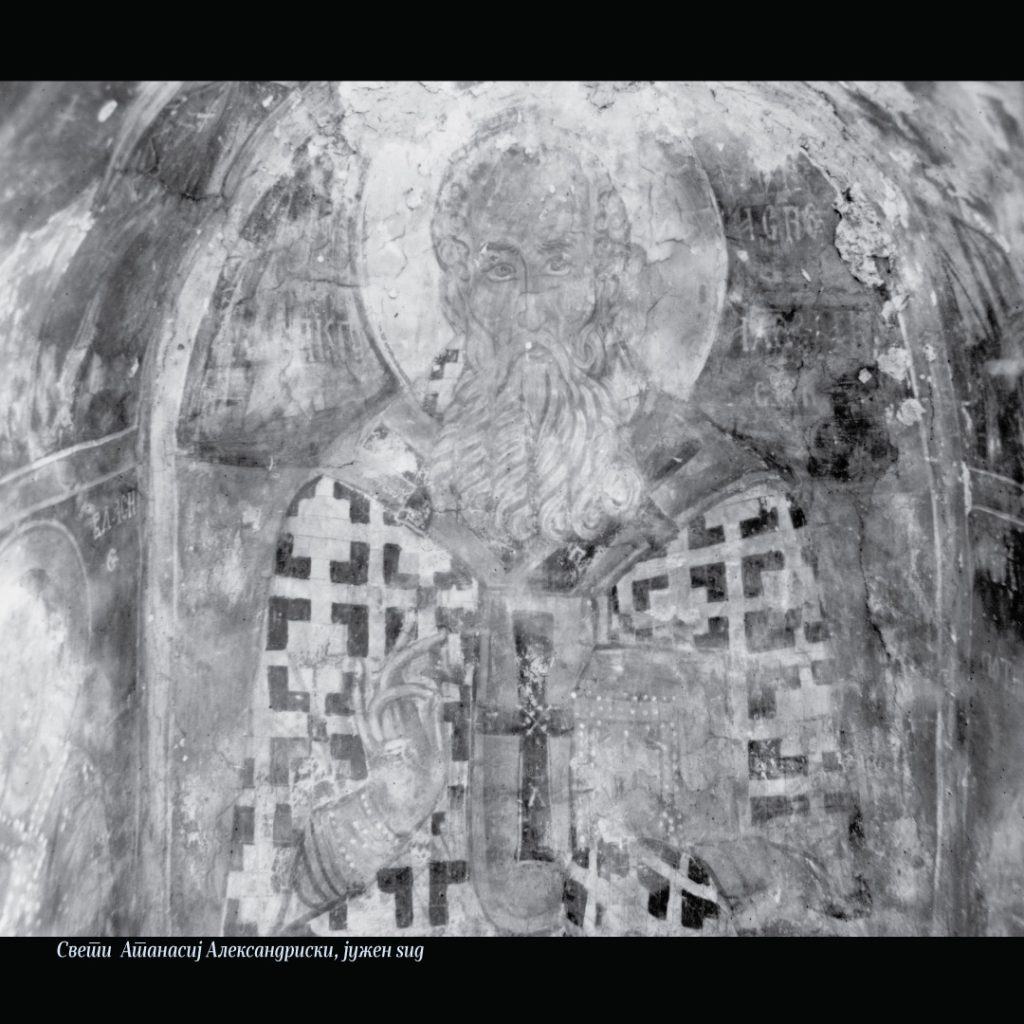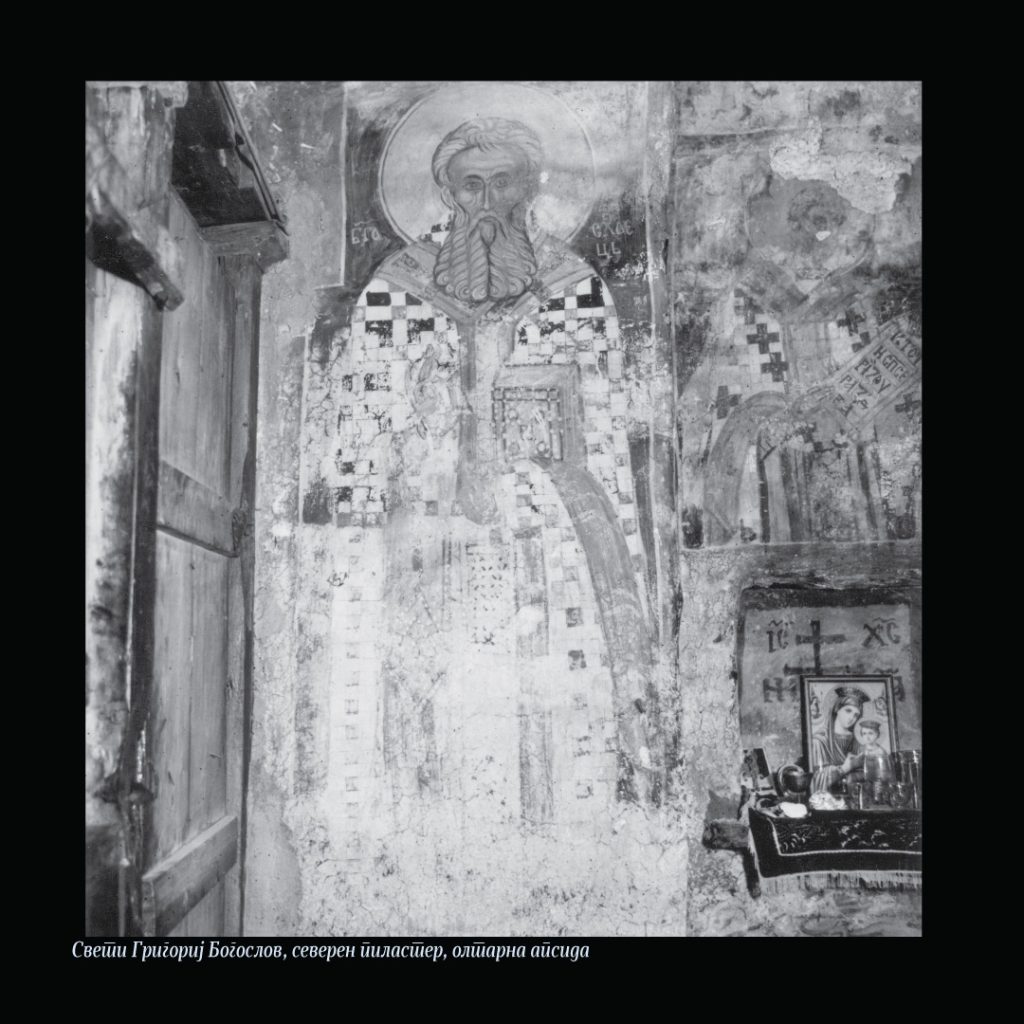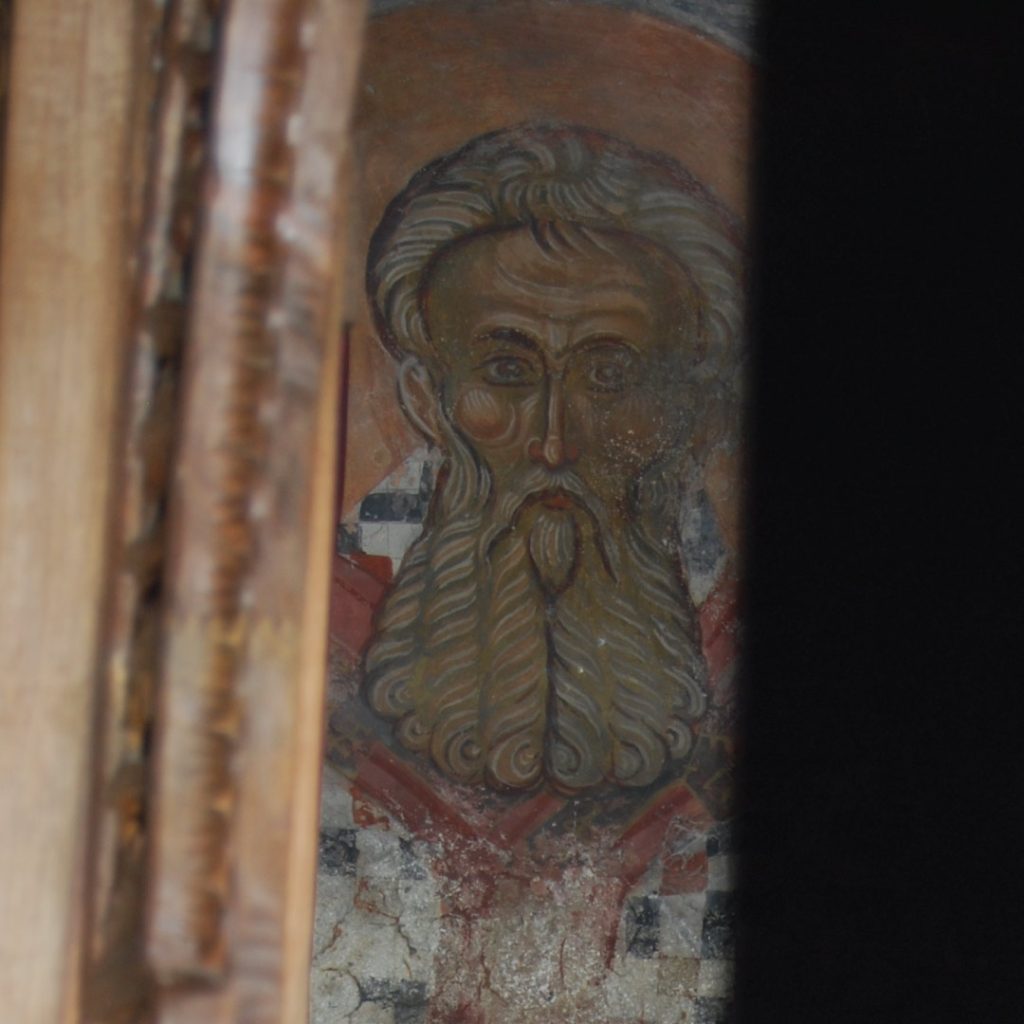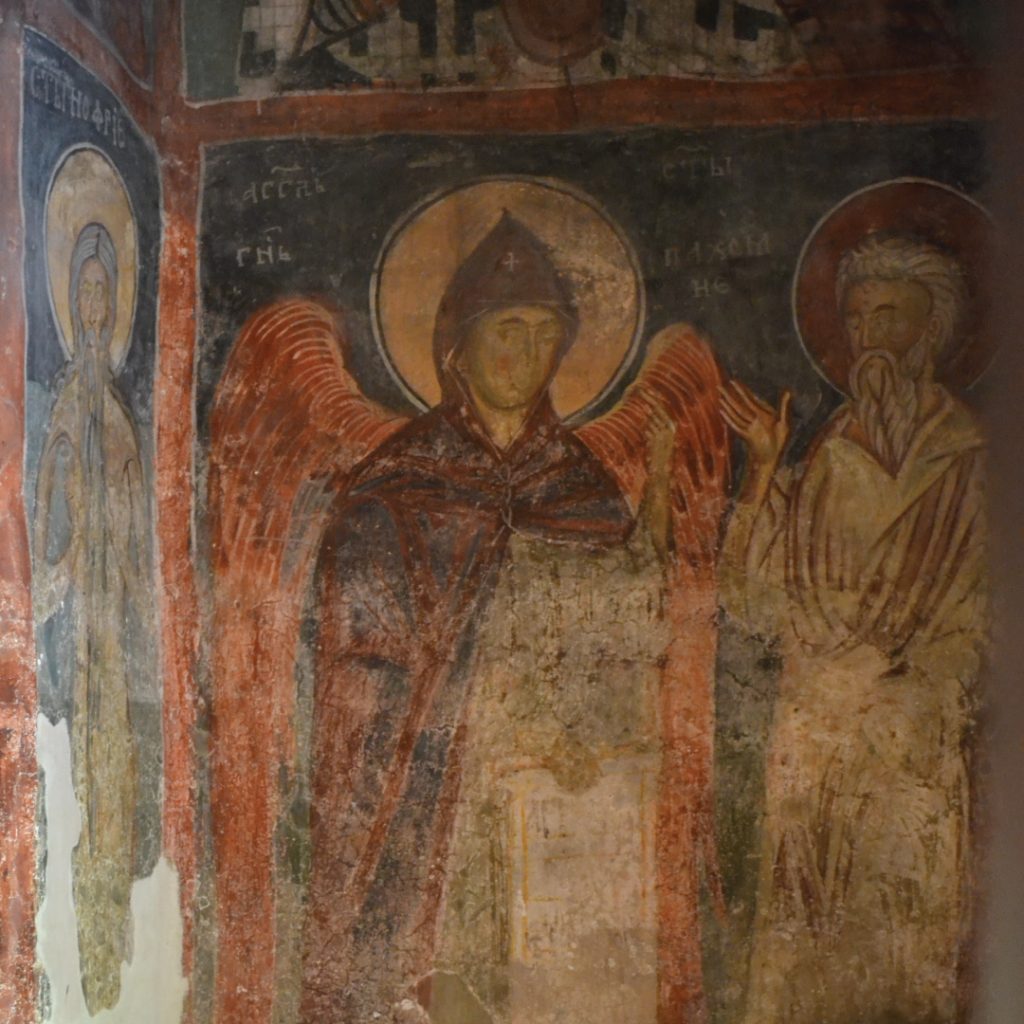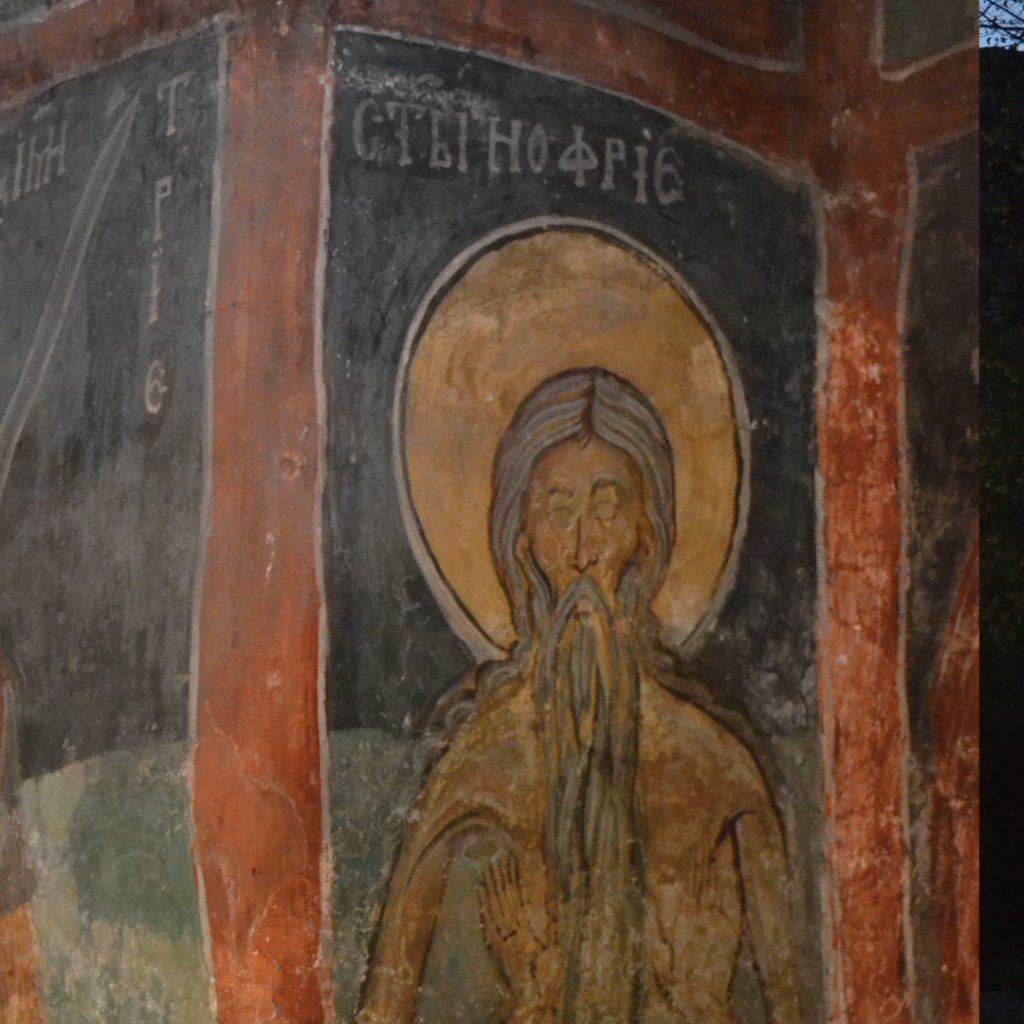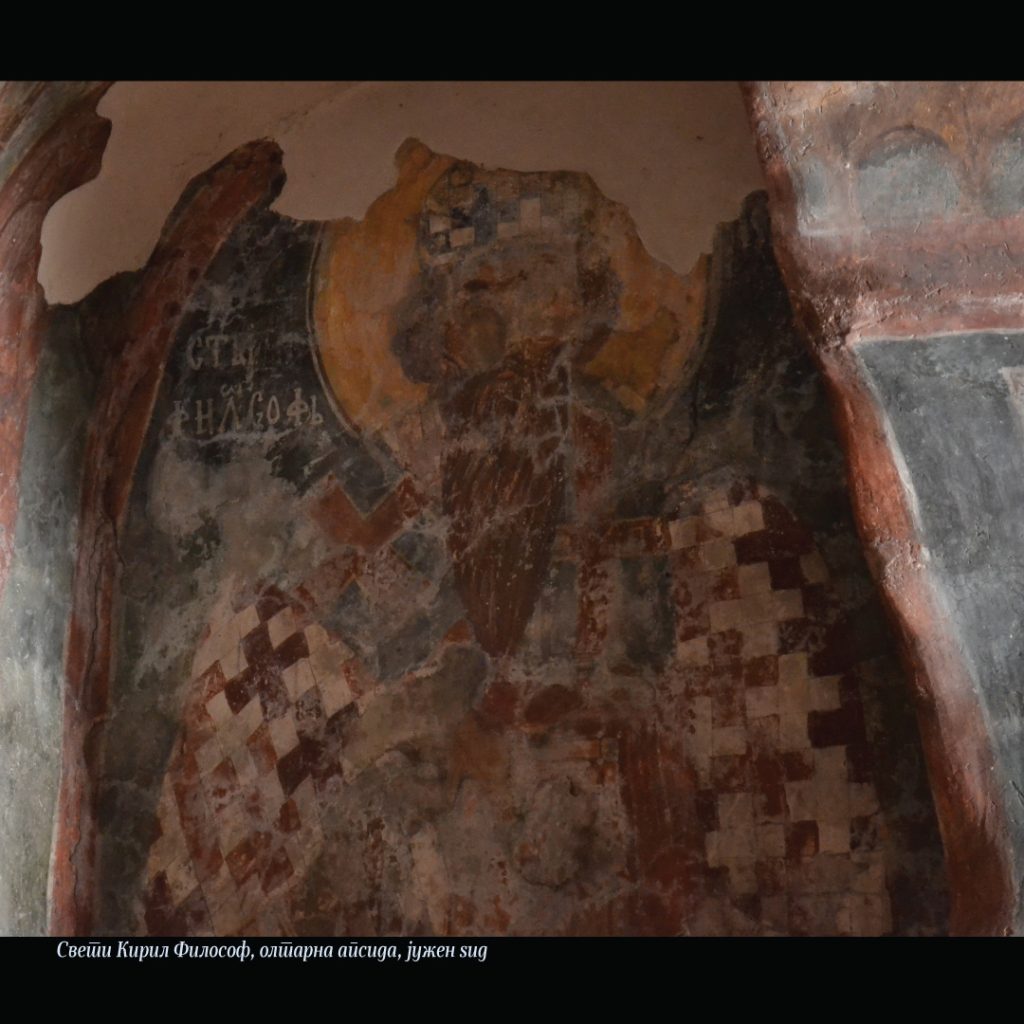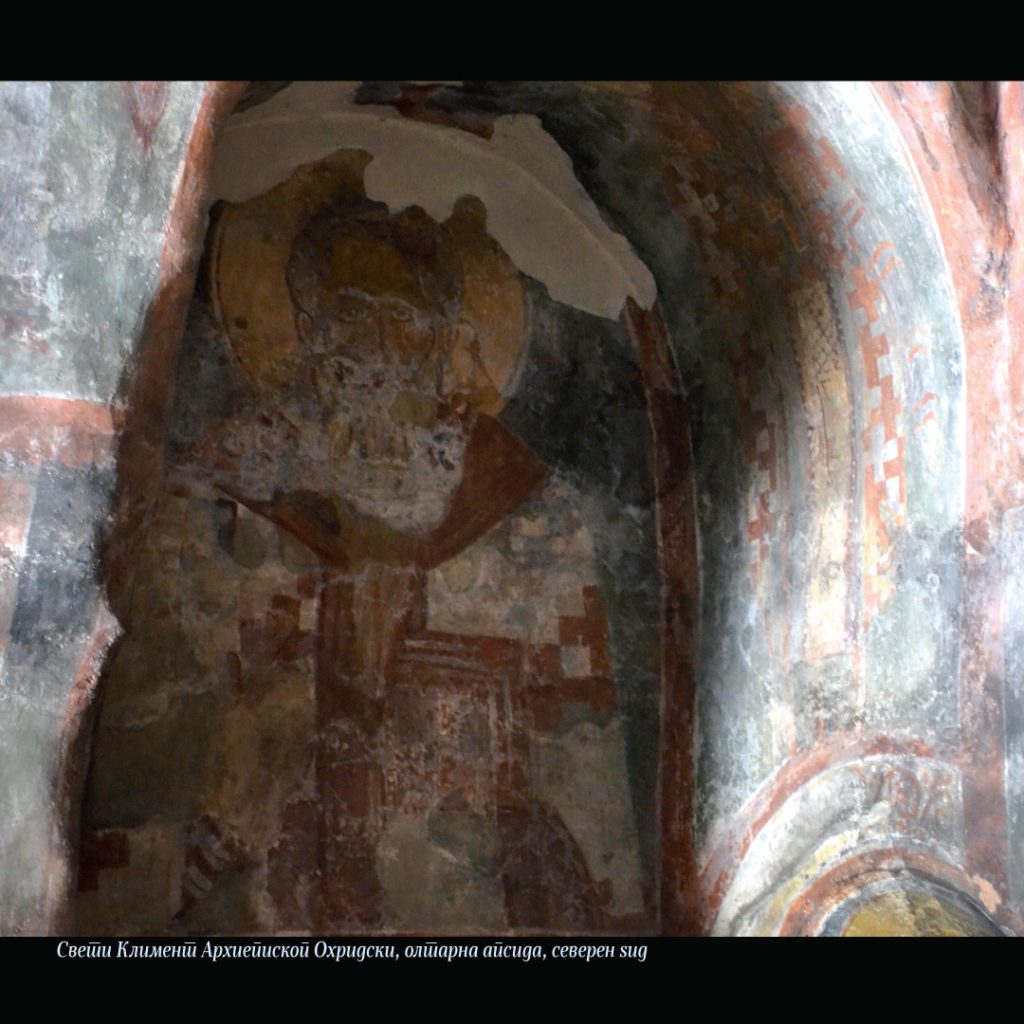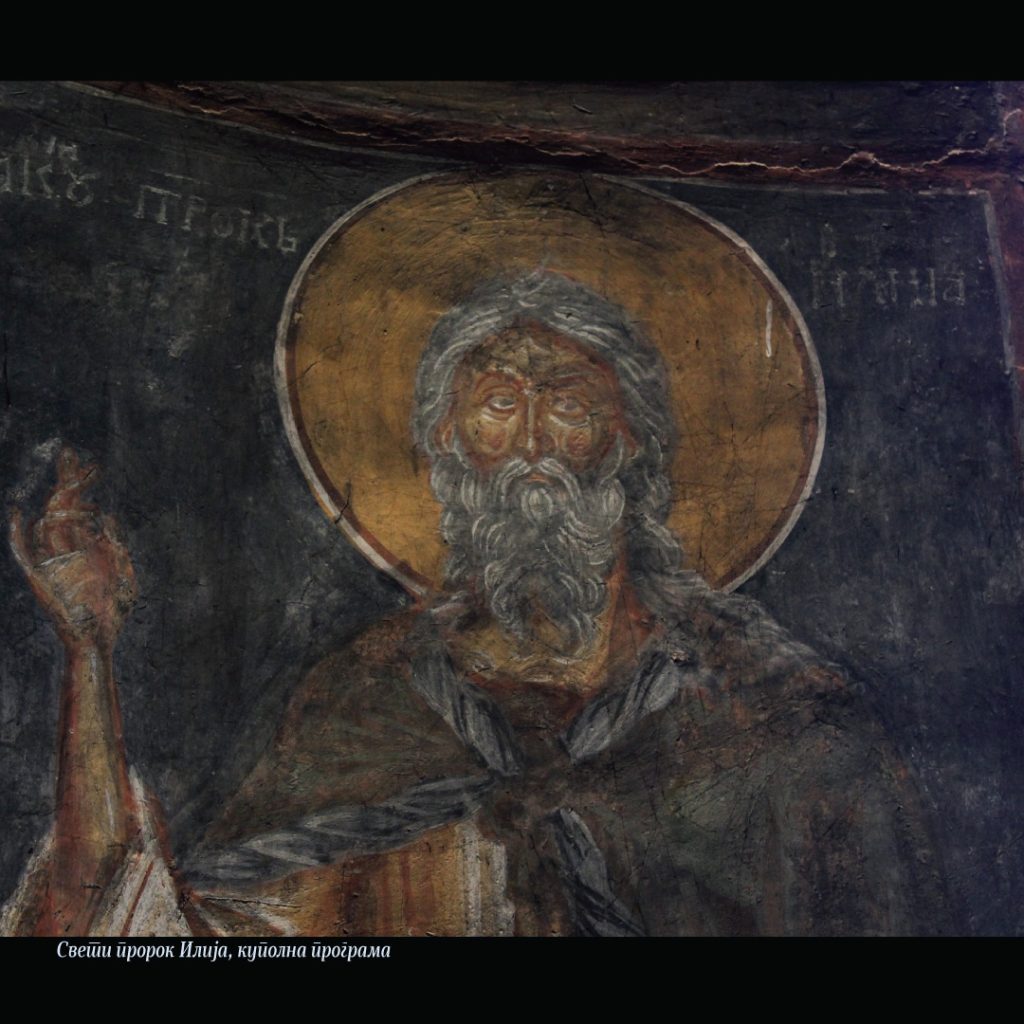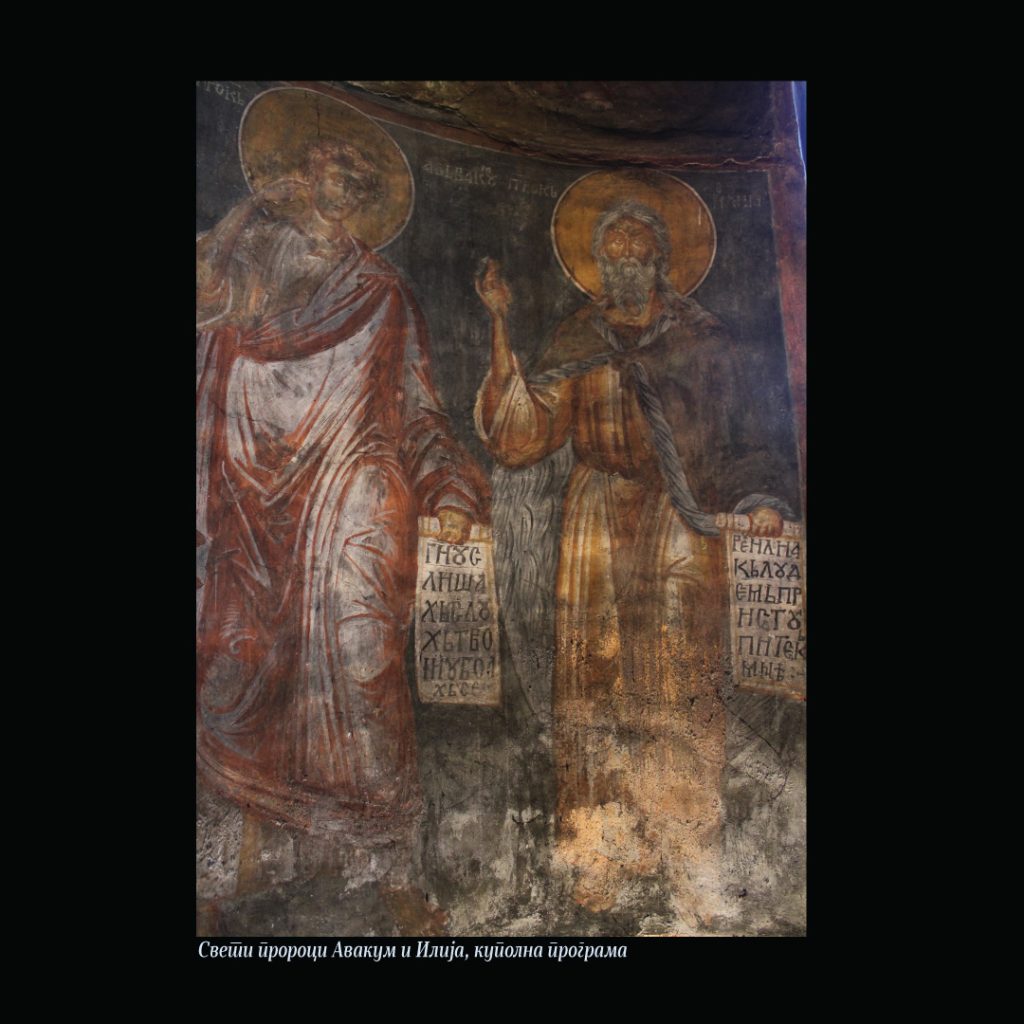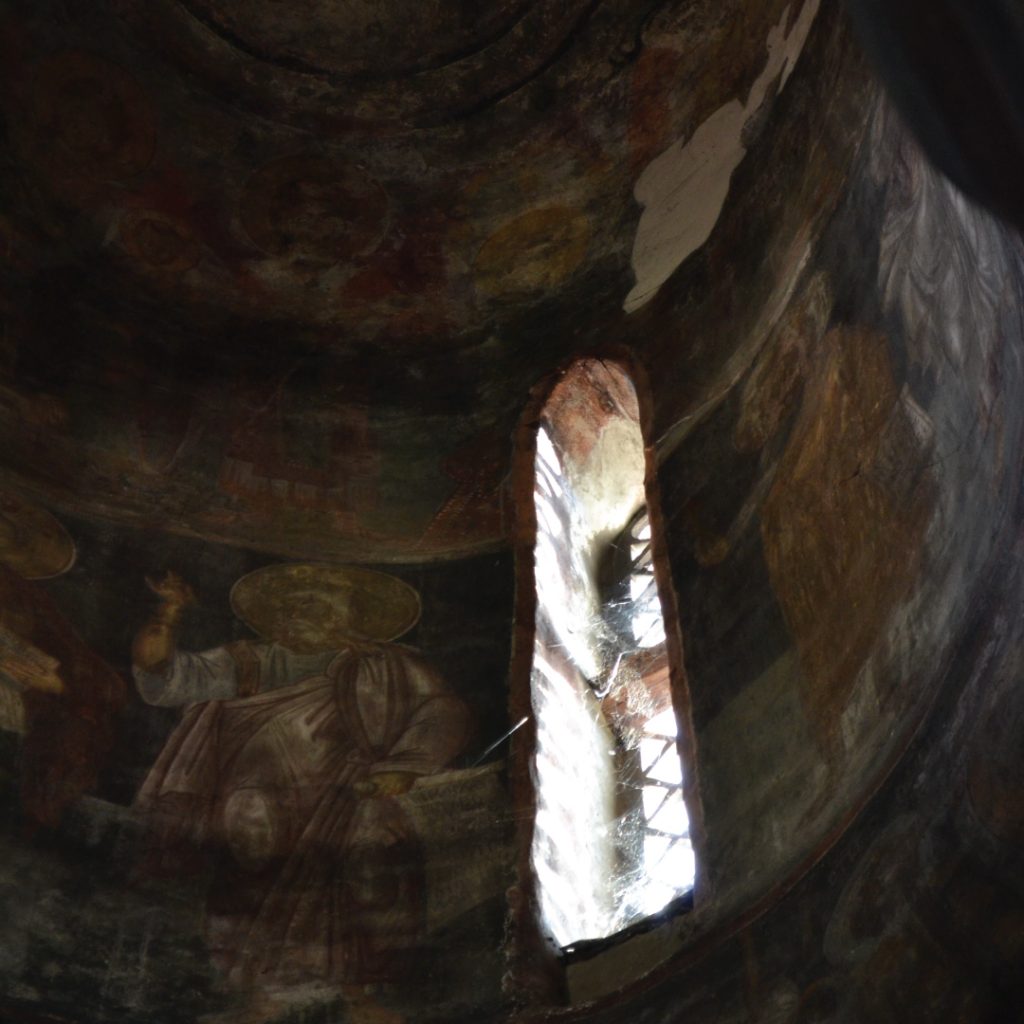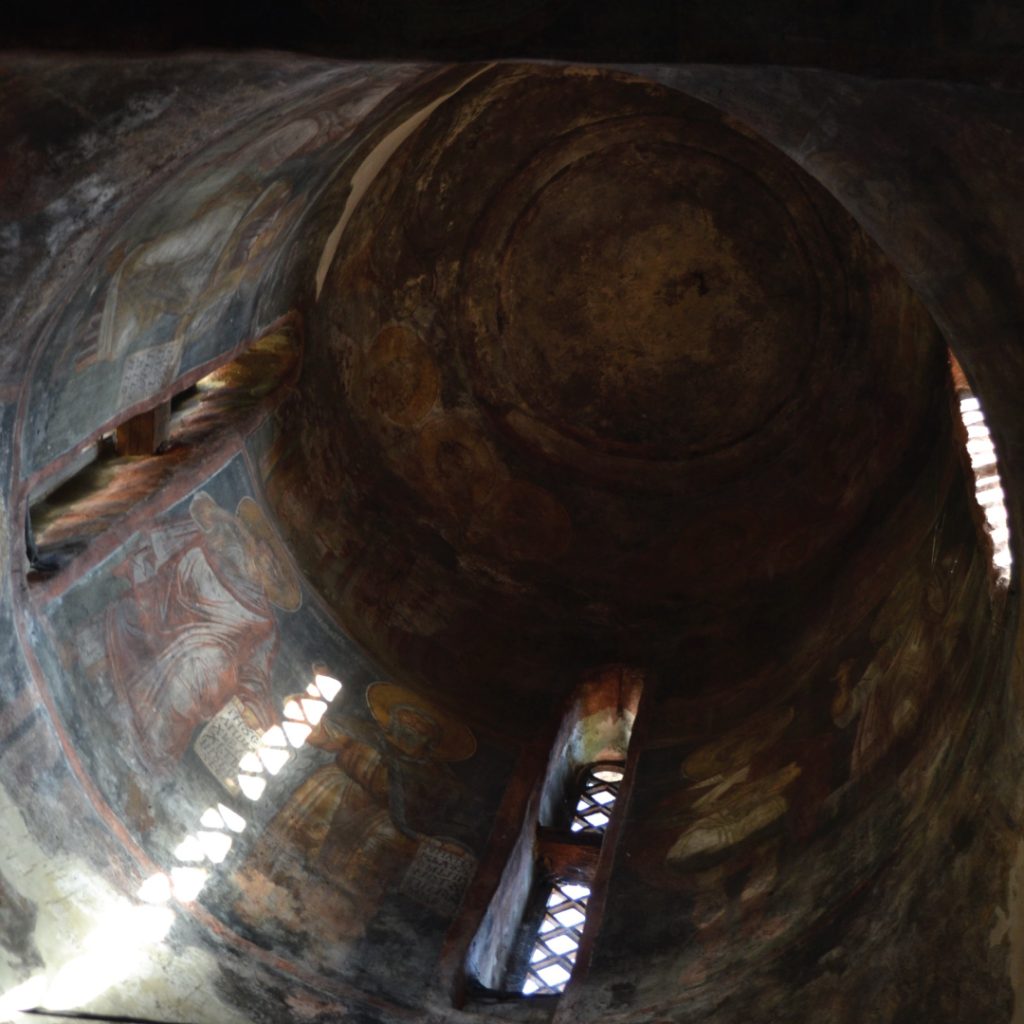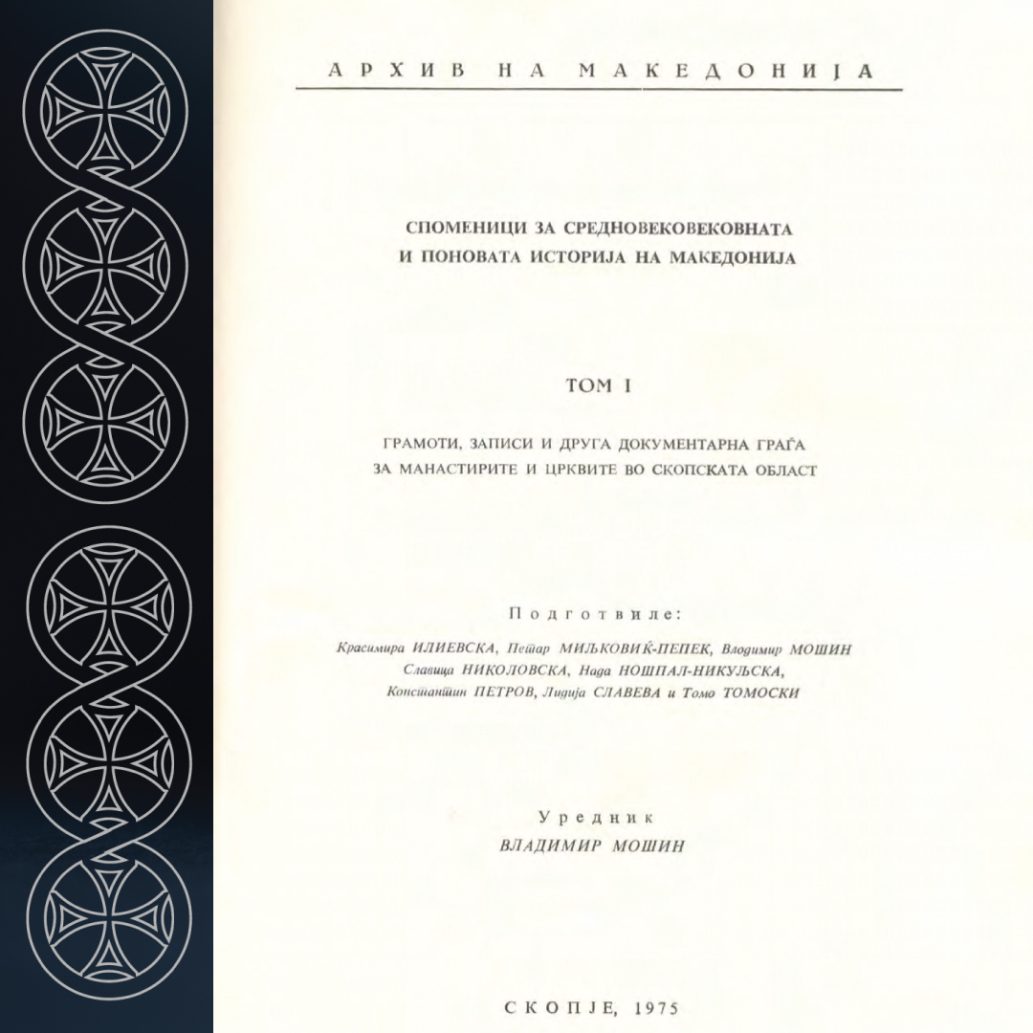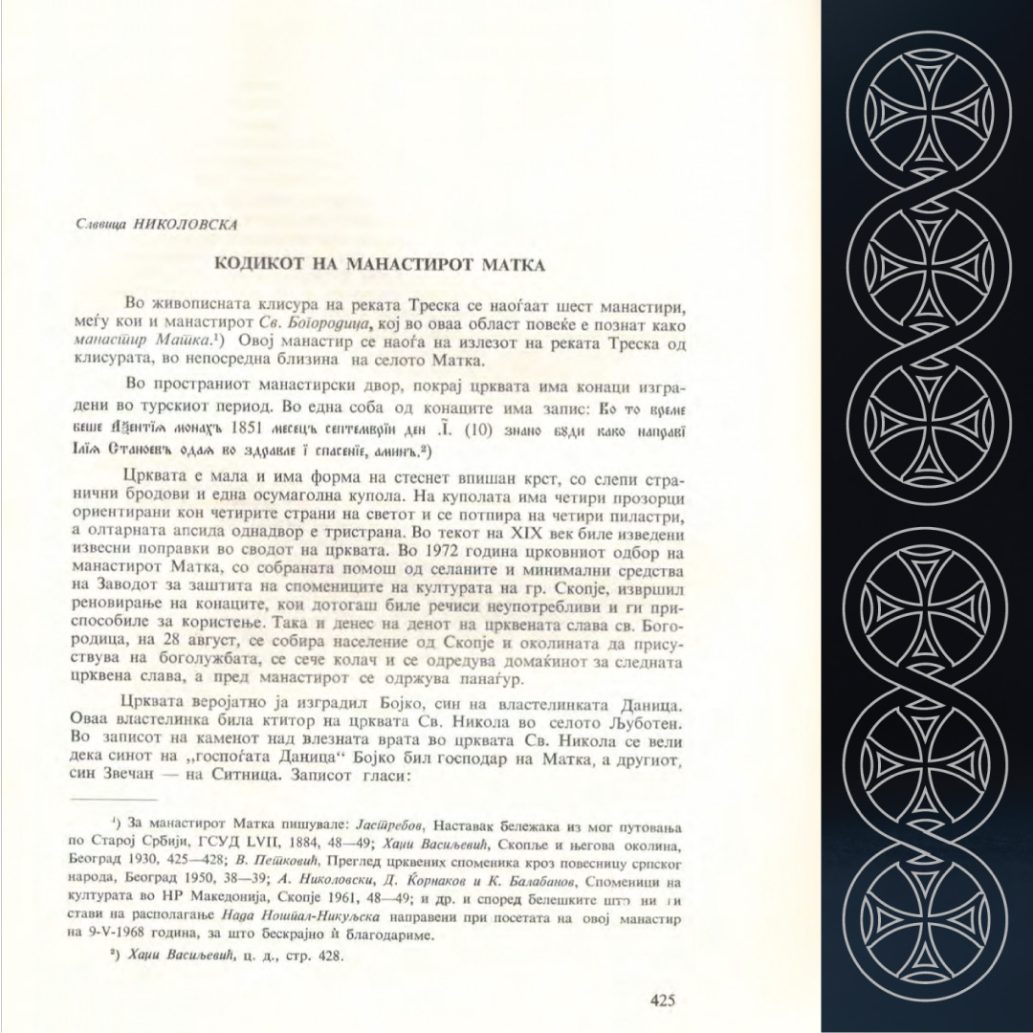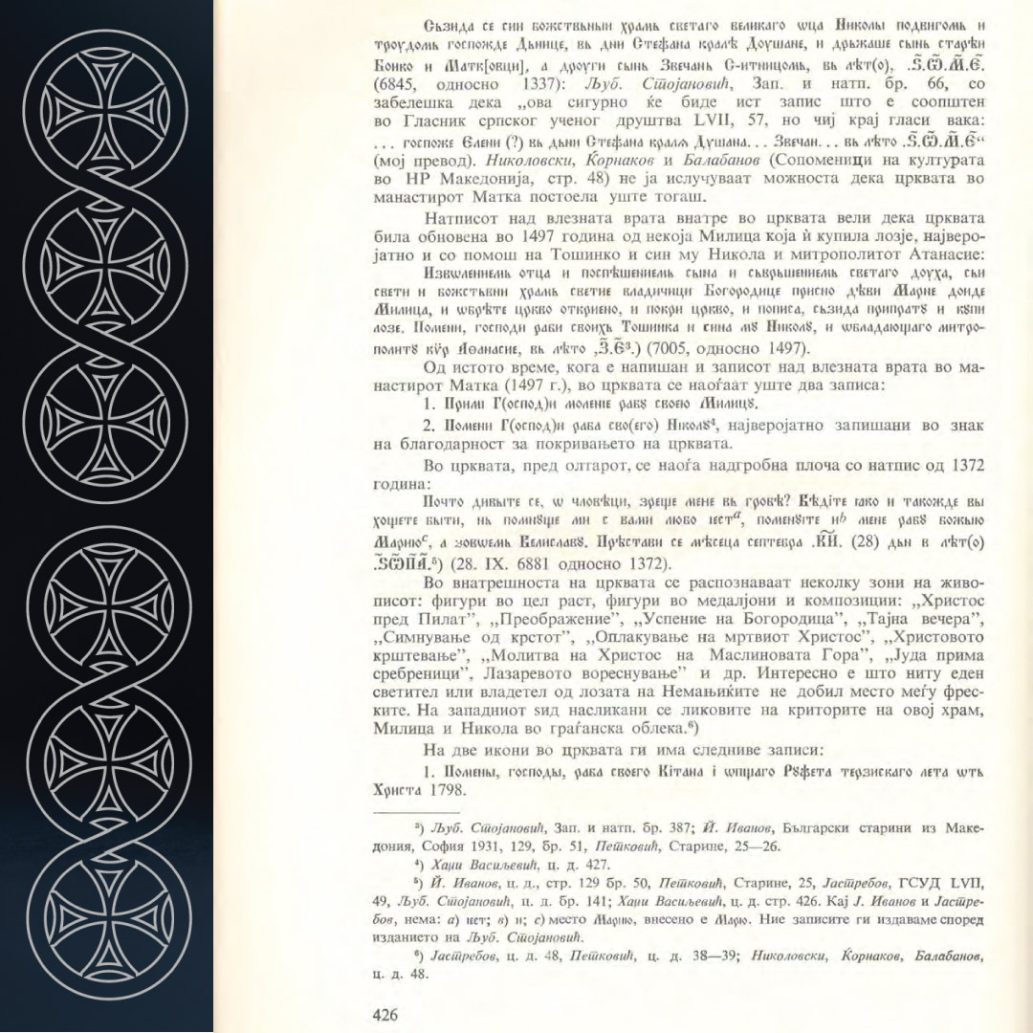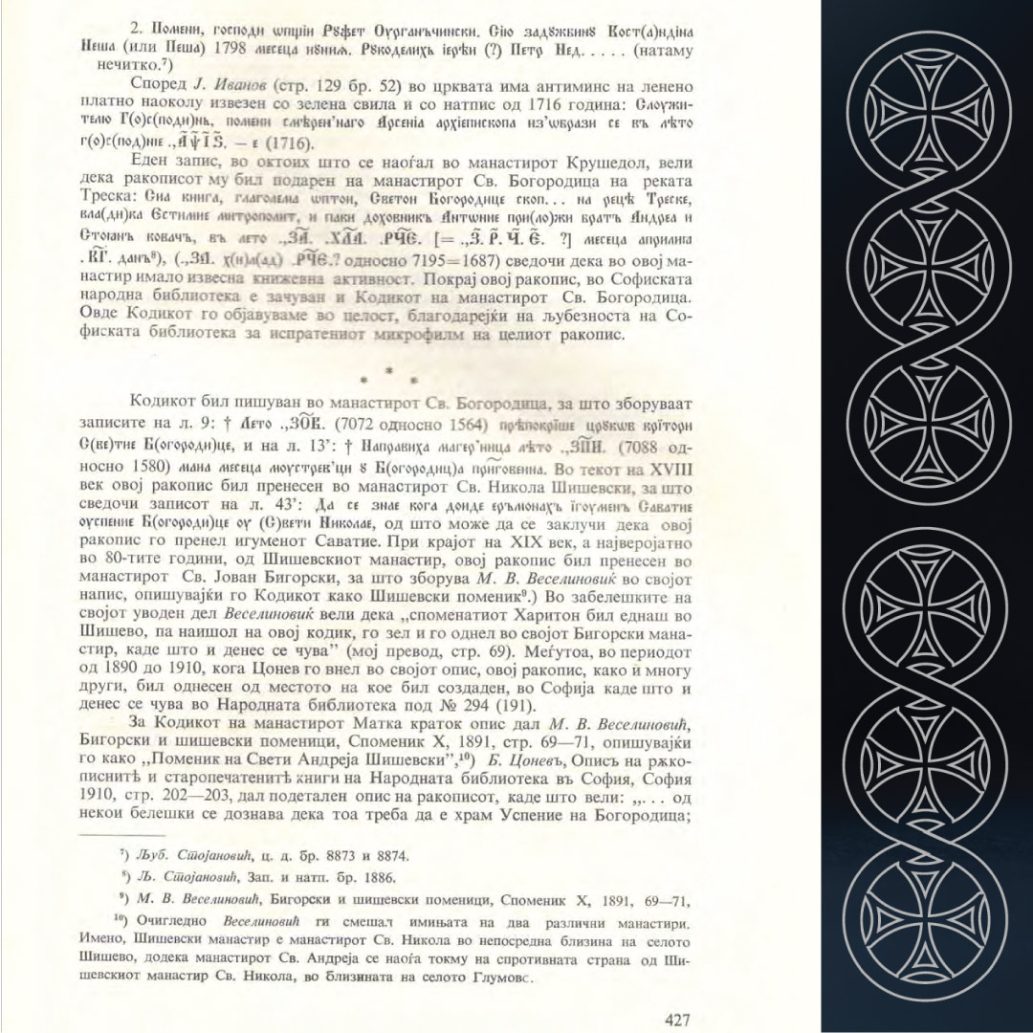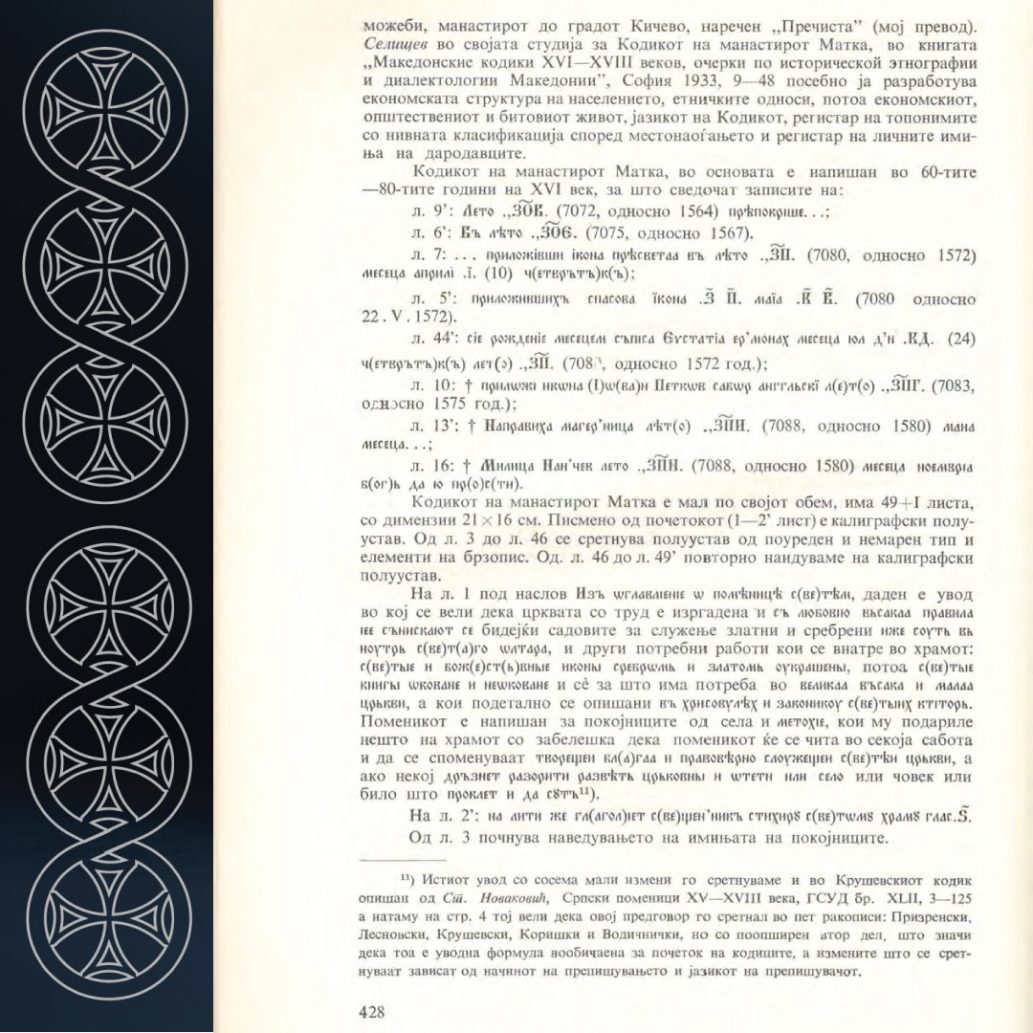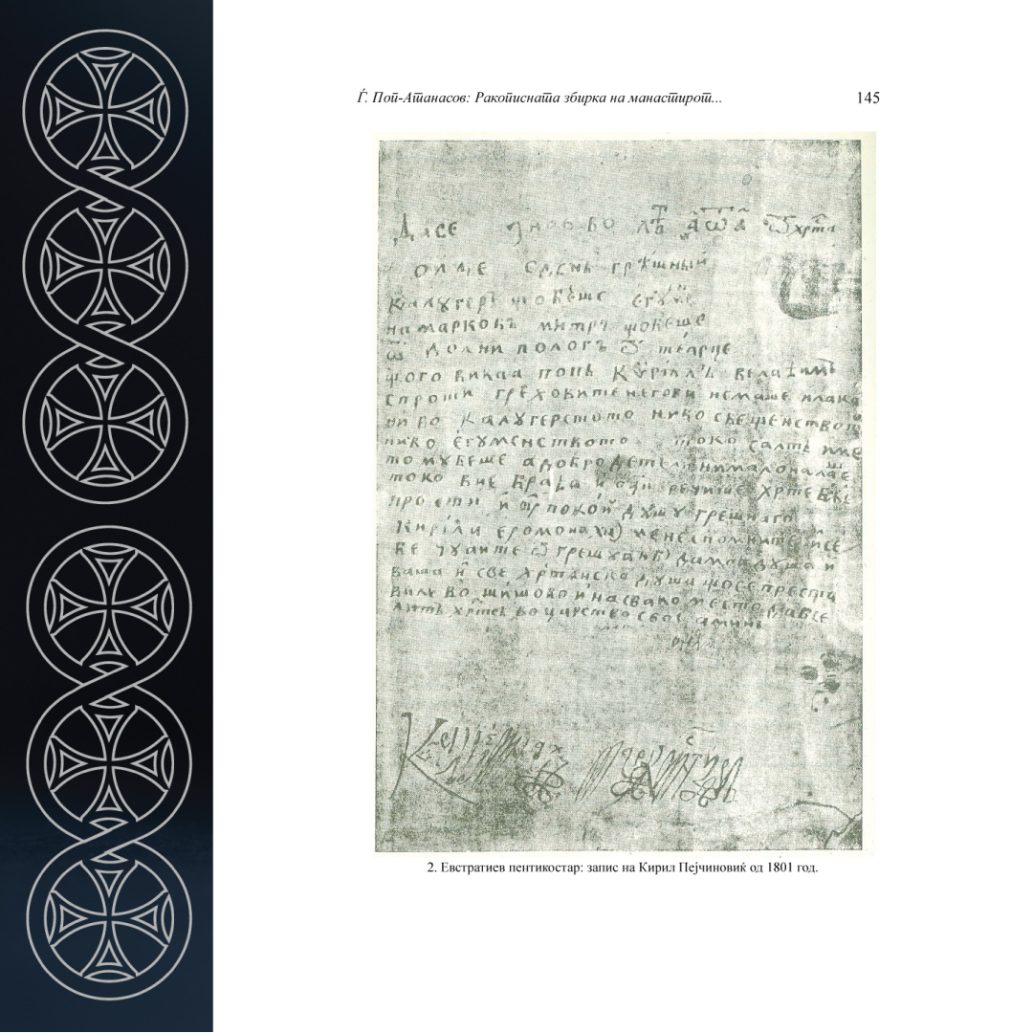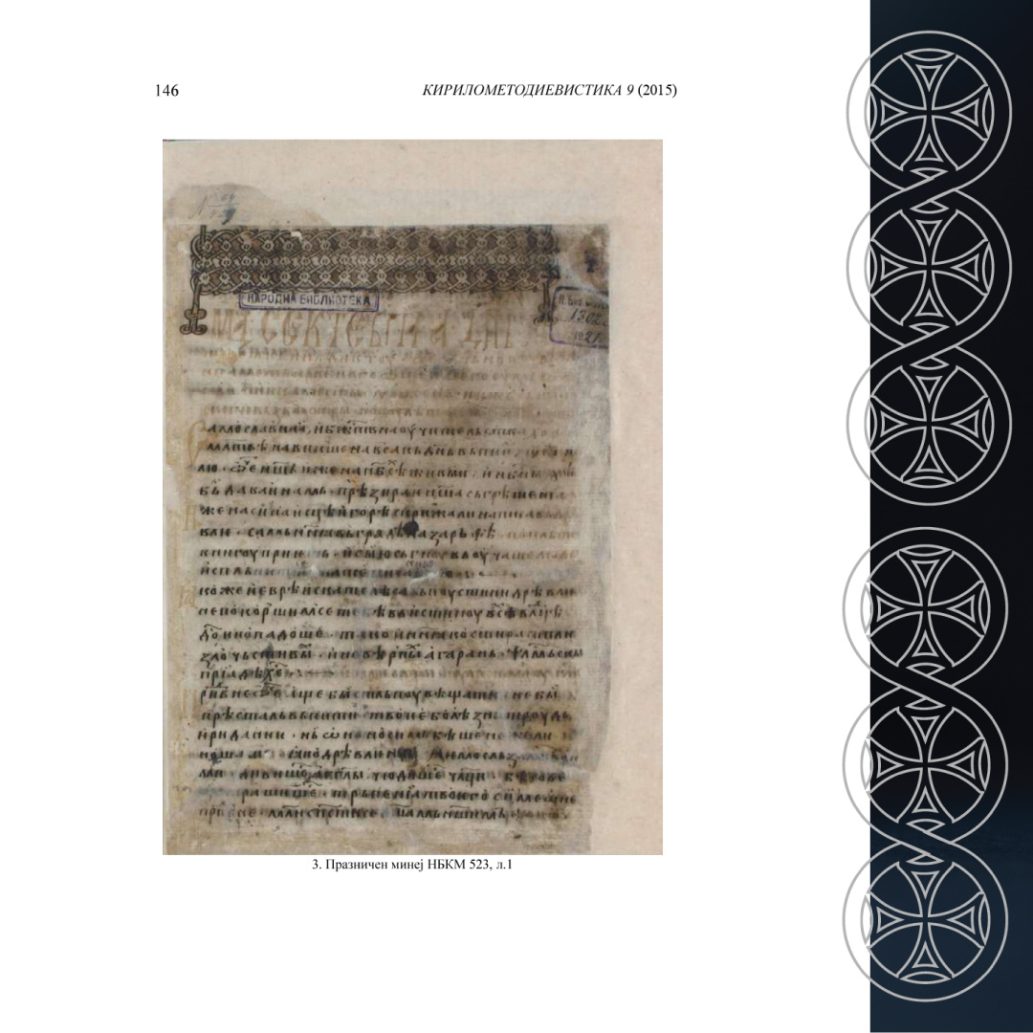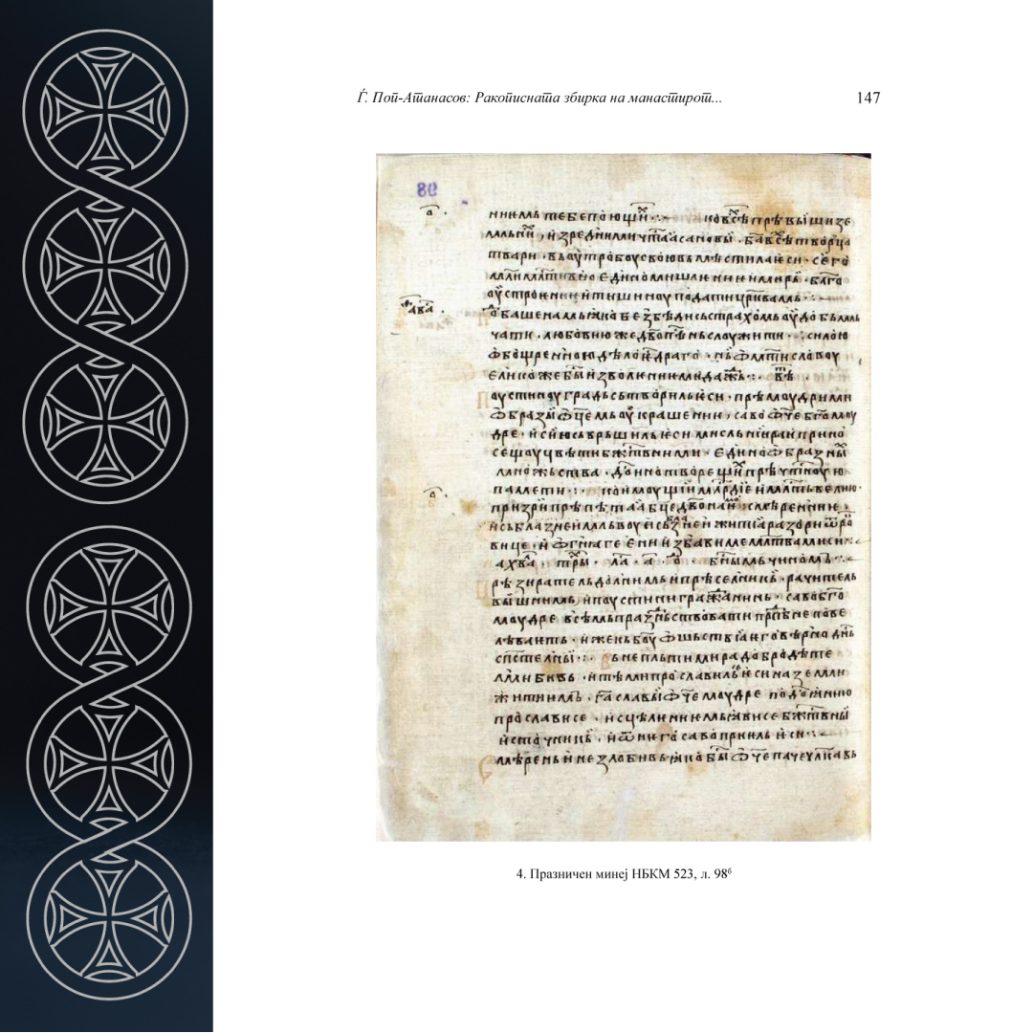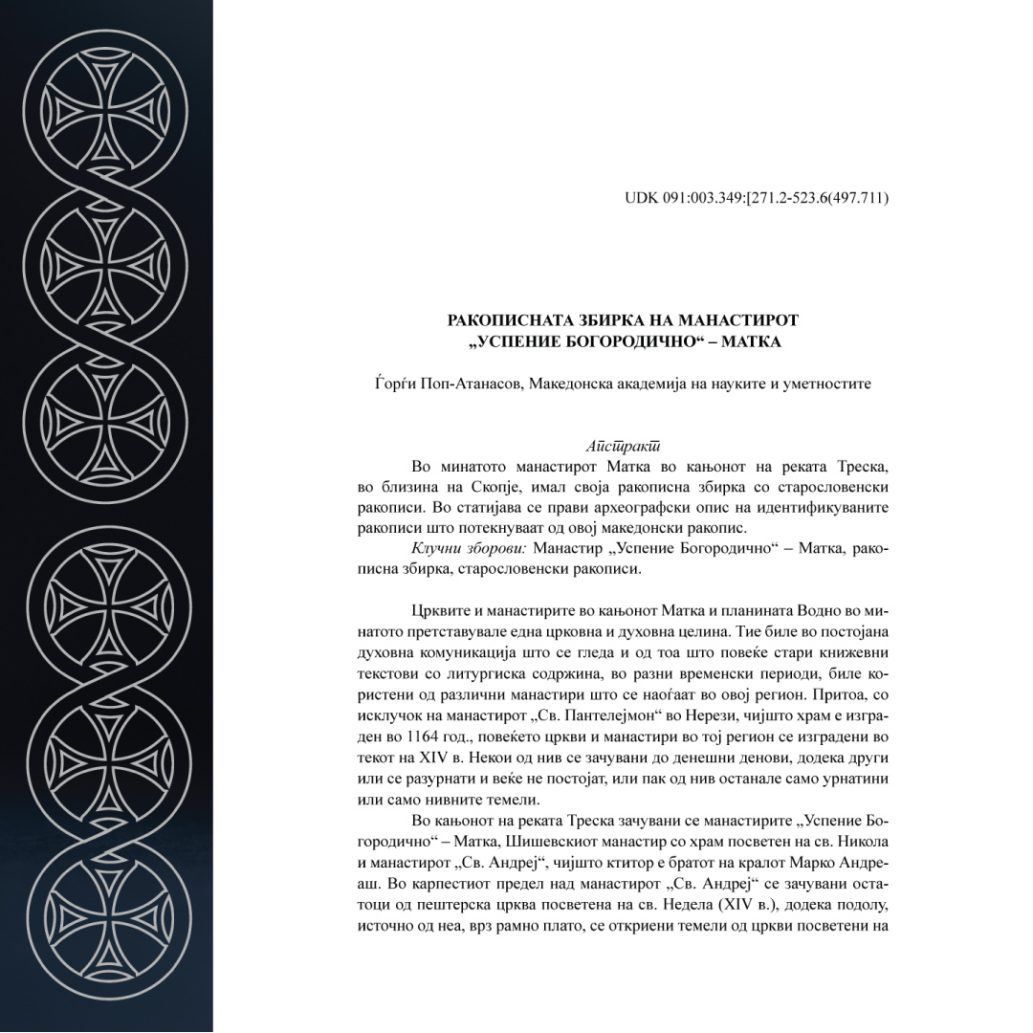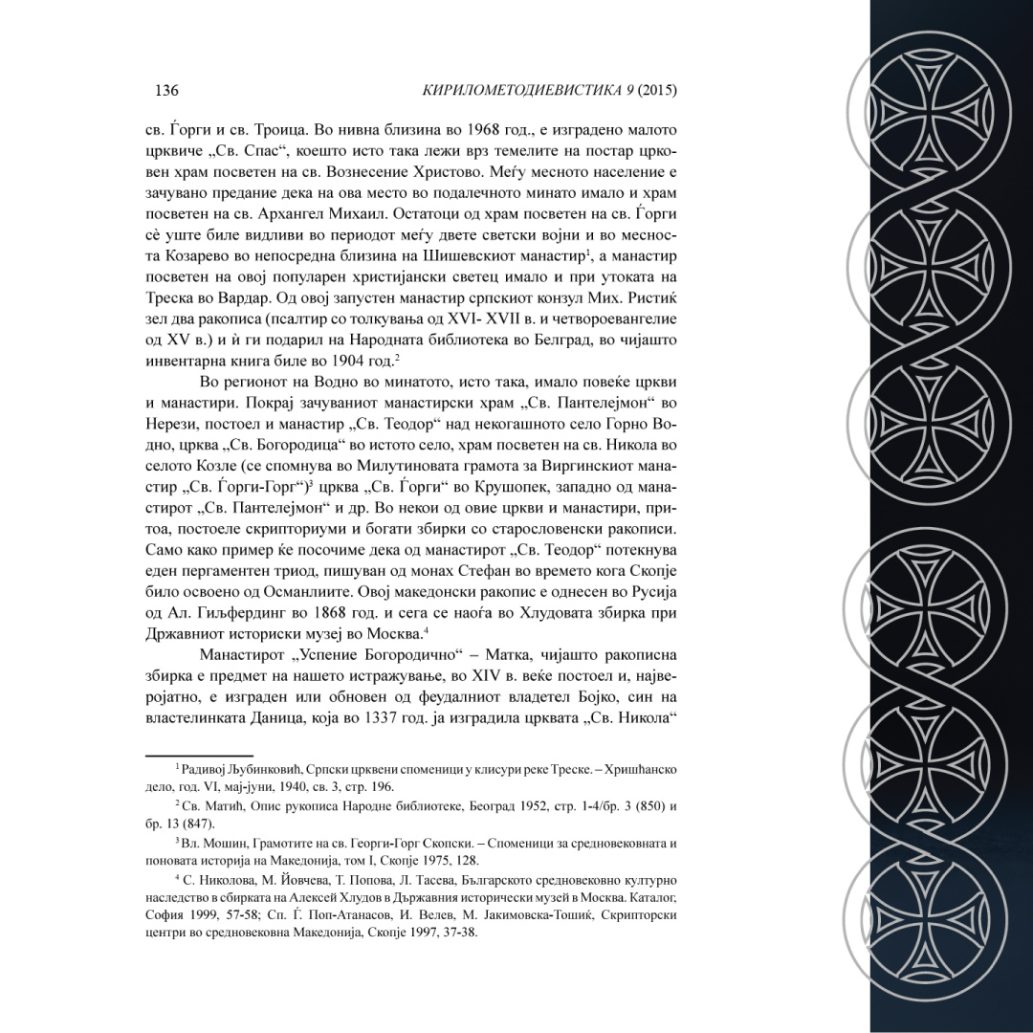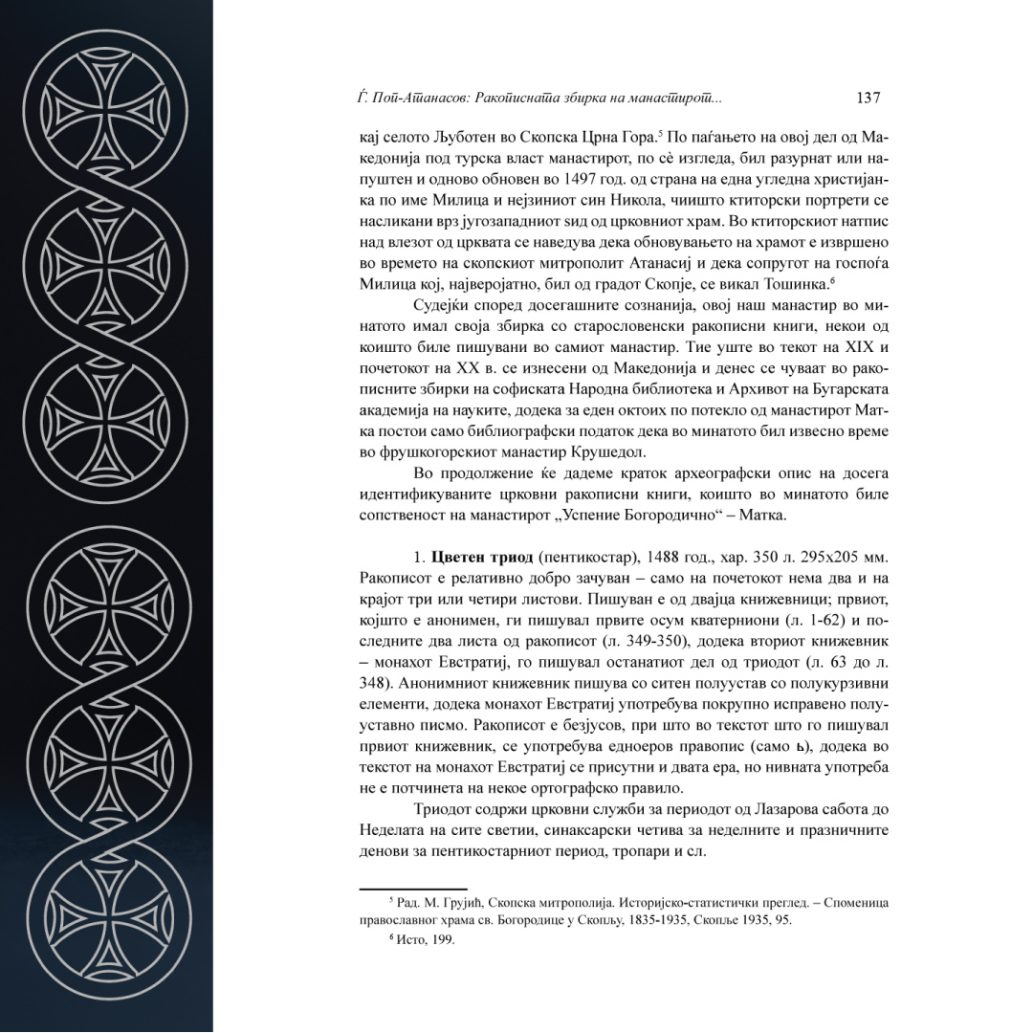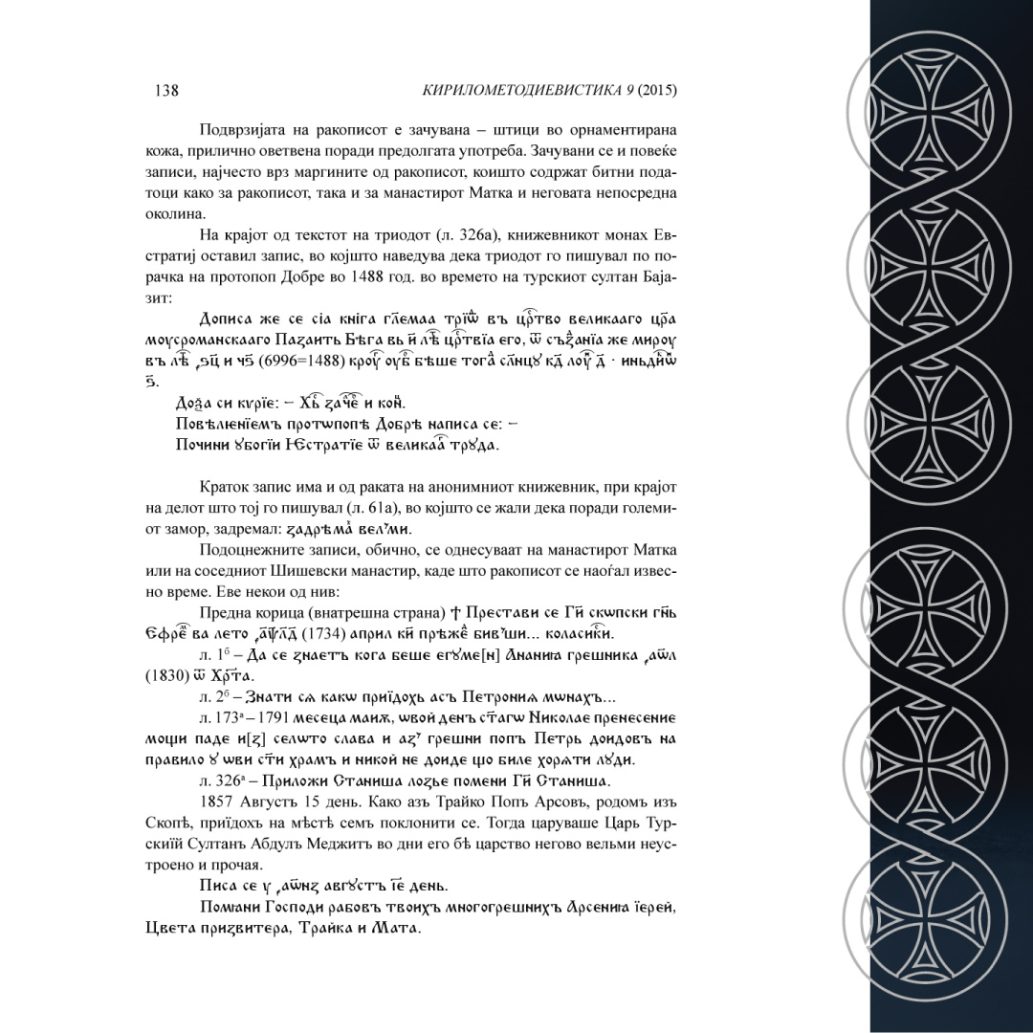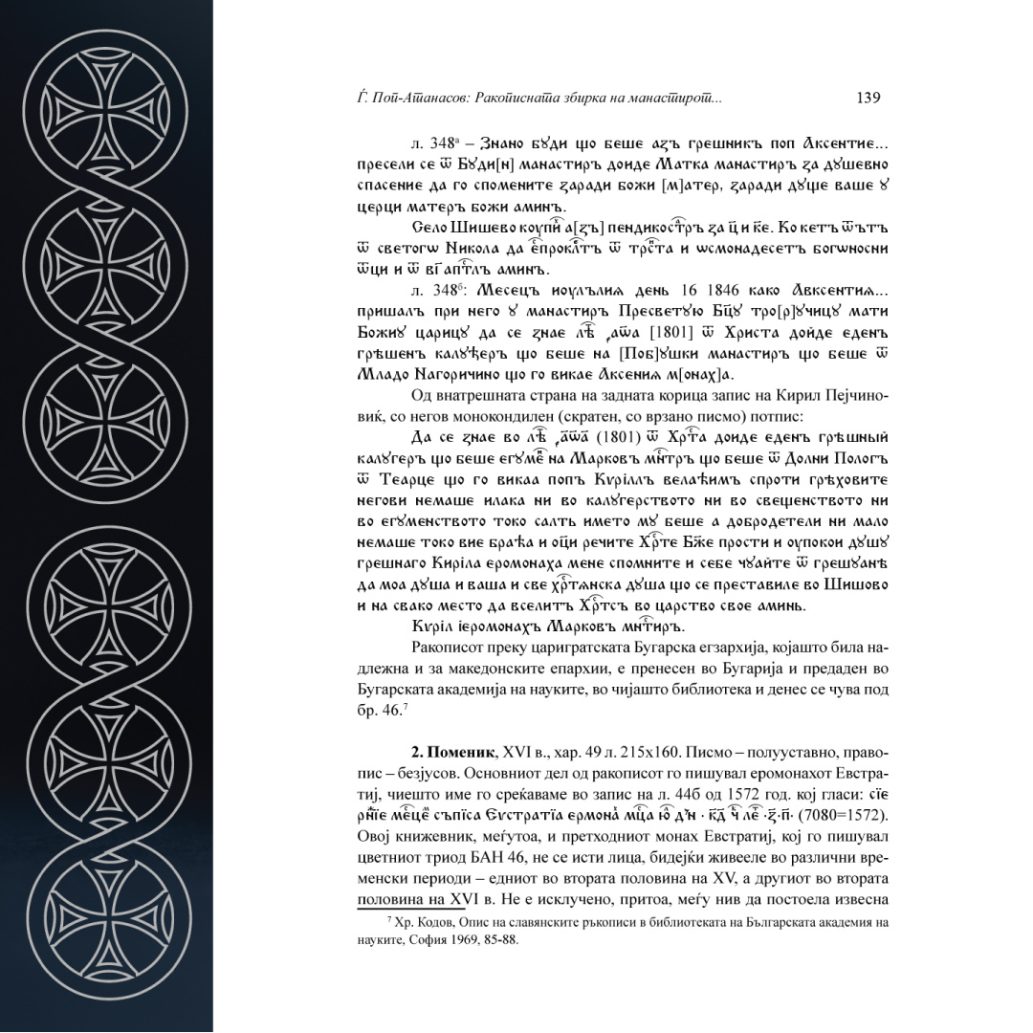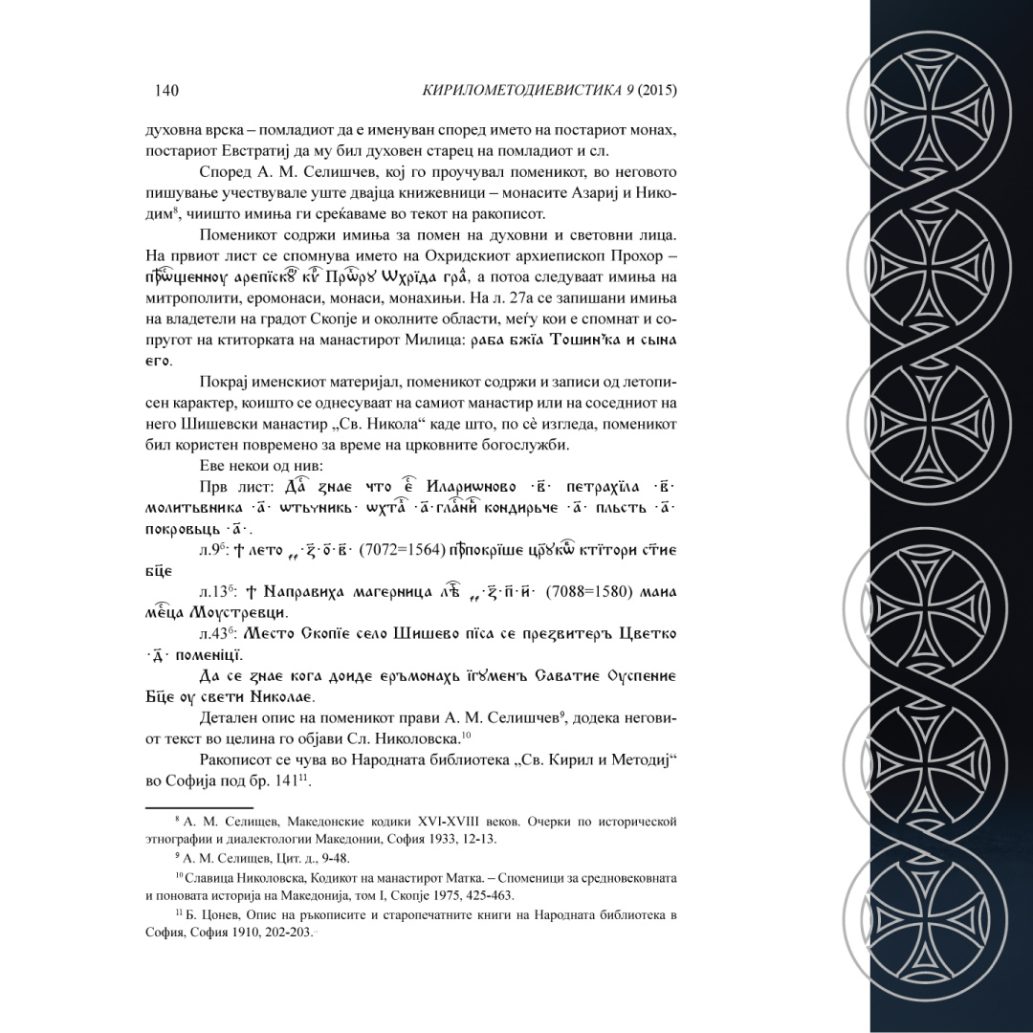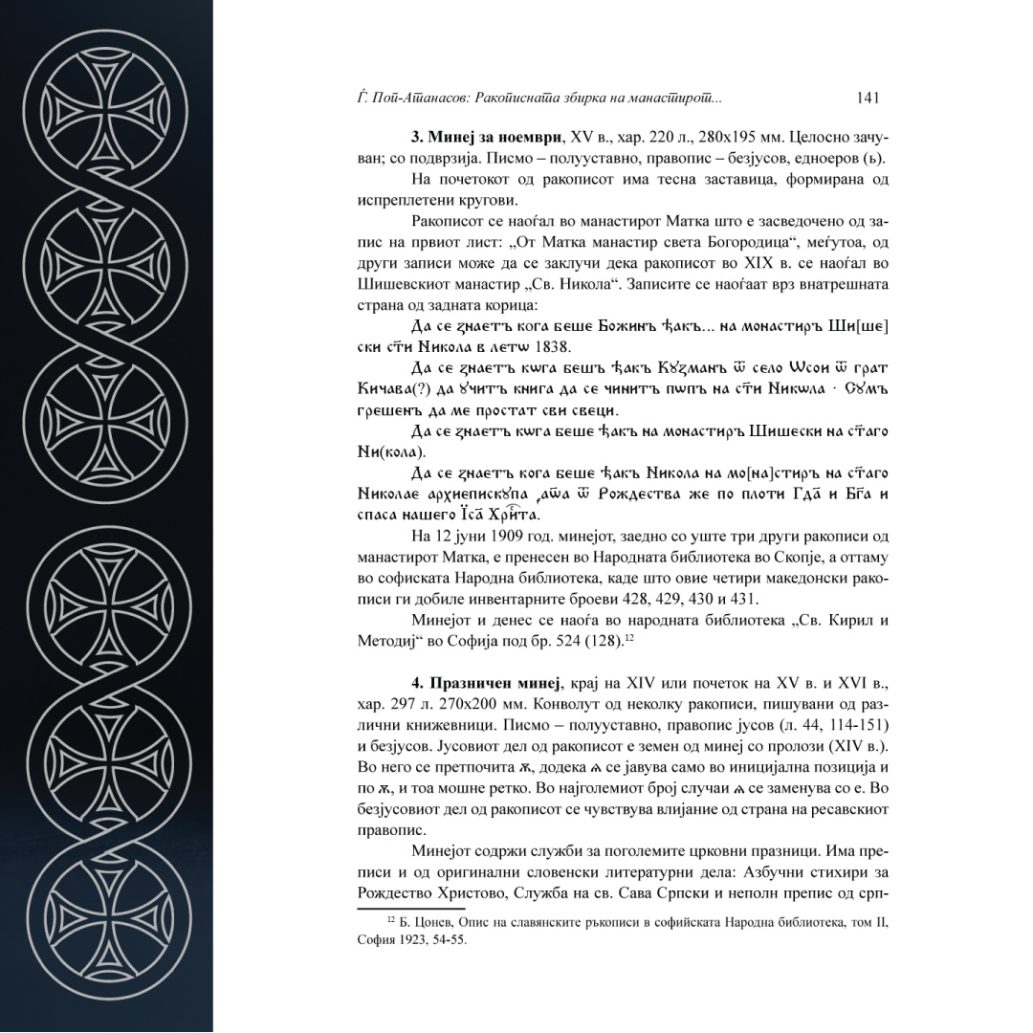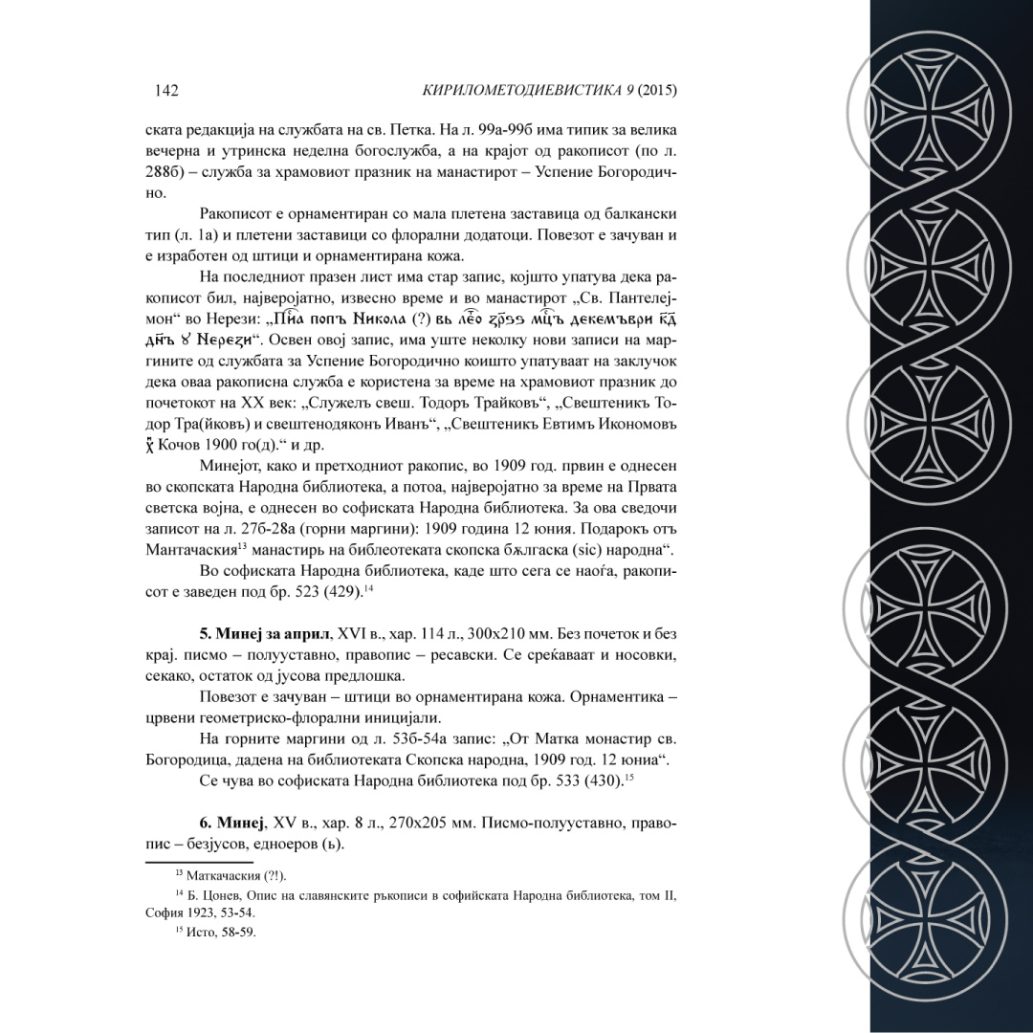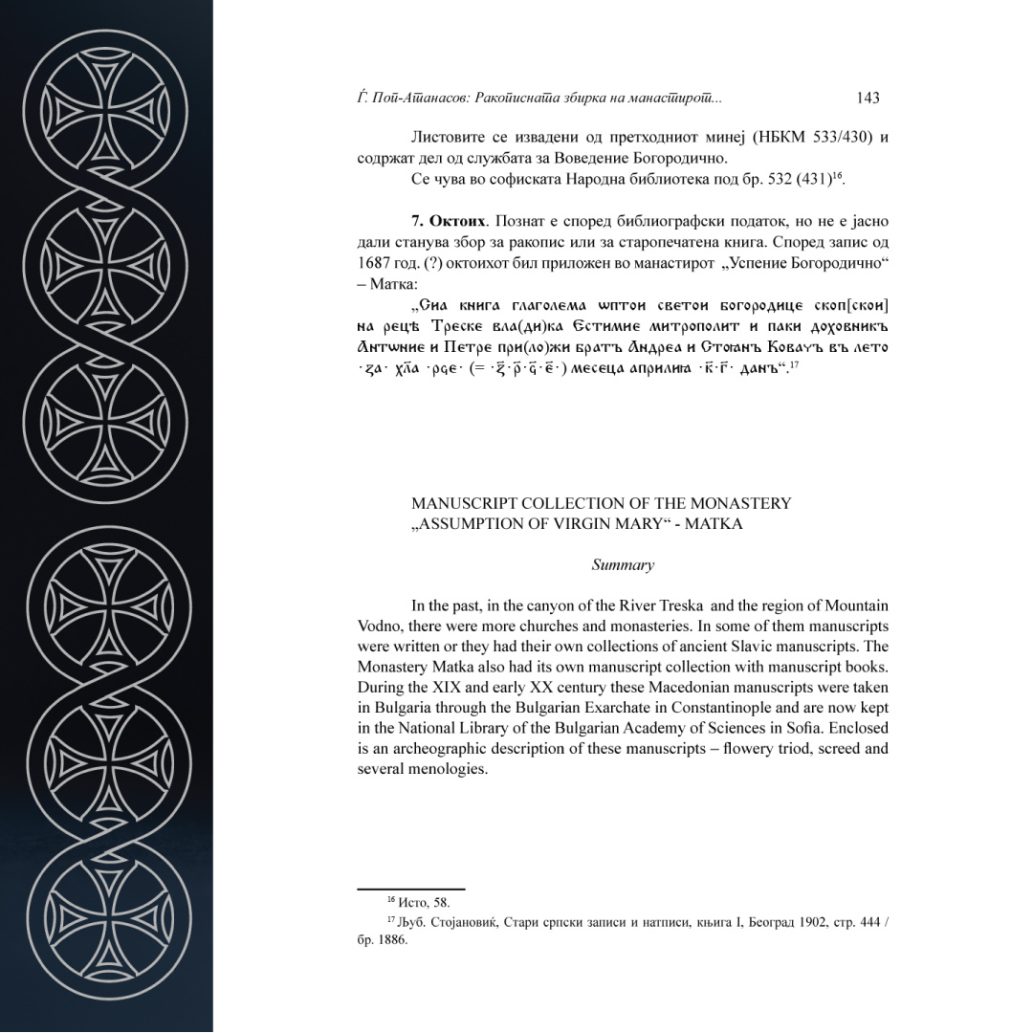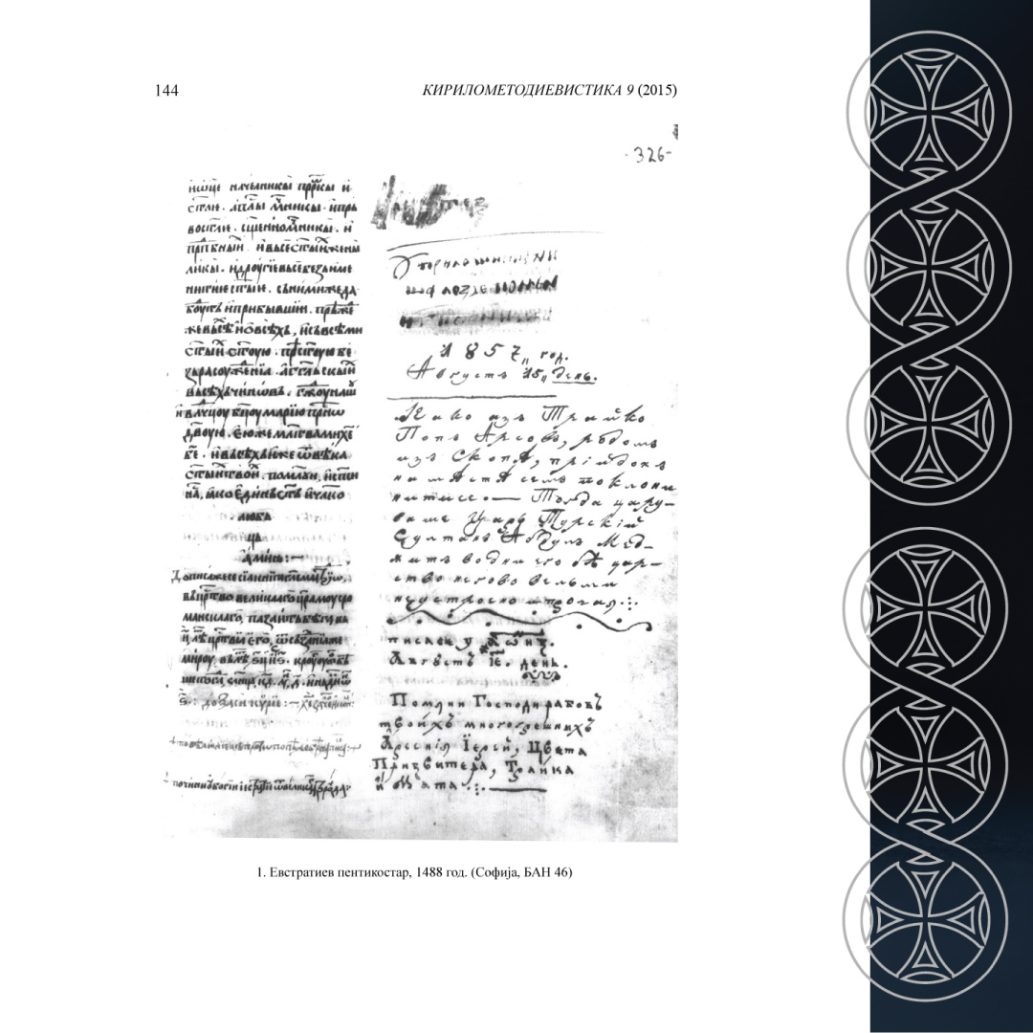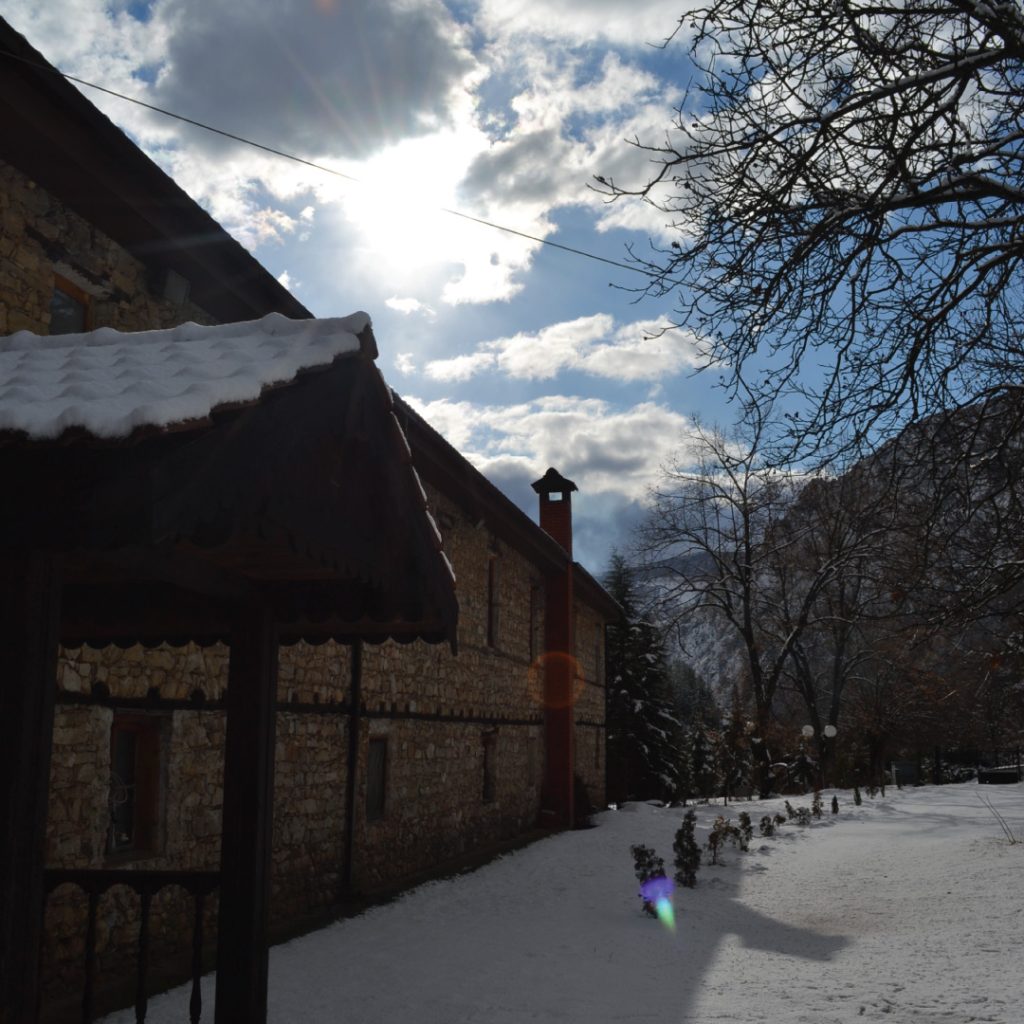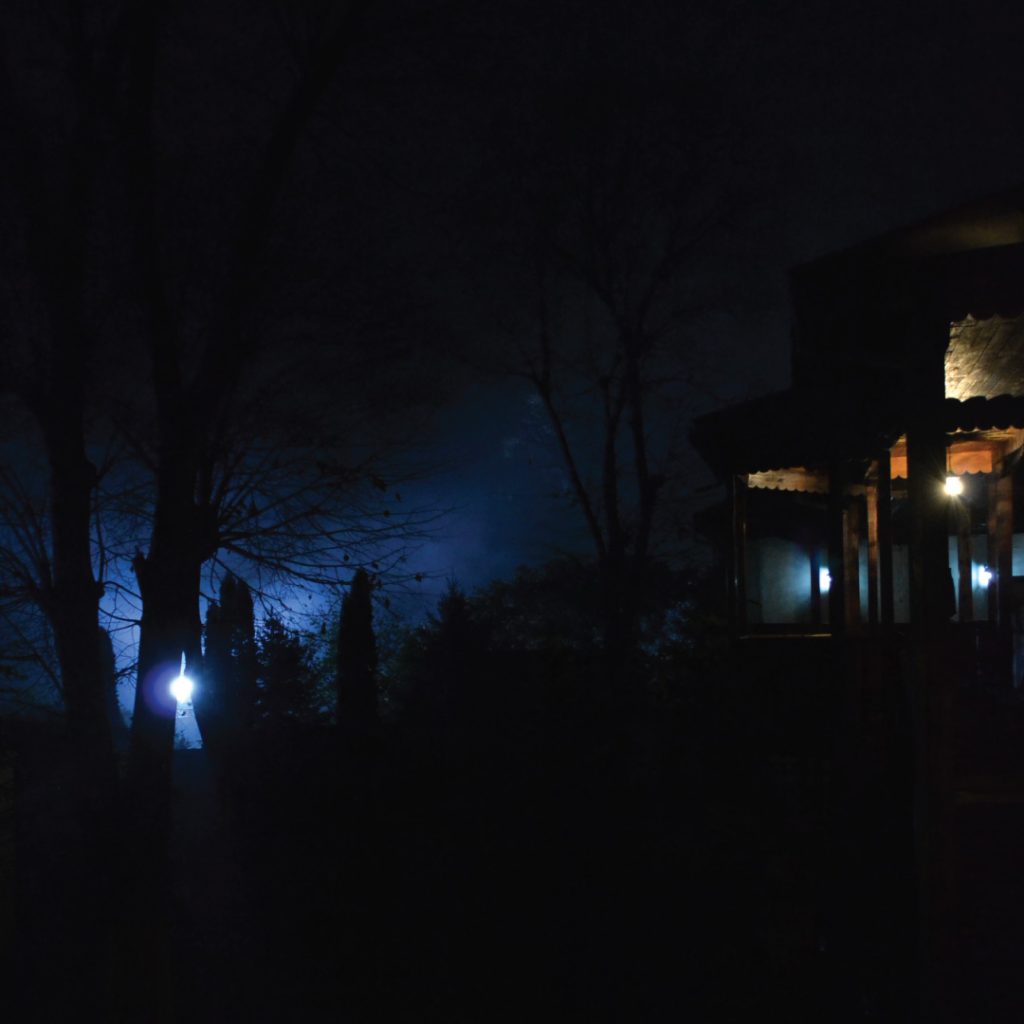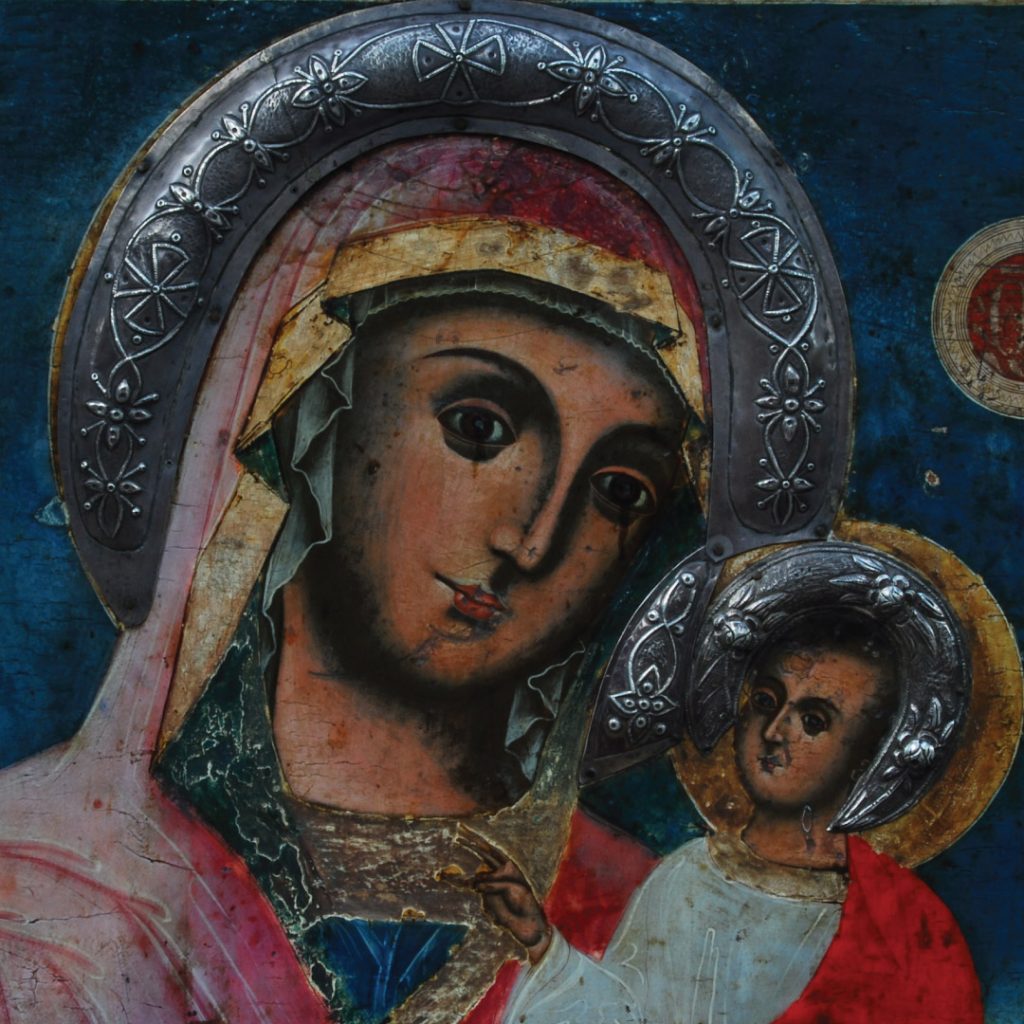The reconstruction and revival of the monastic life today is, as always, based on the renewed practice of the eucharistic and hesychastic life in the parishes, and the monasteries (it is the fruit of repentance of the people).
The Tradition about the Jesus prayer in Macedonia and in Matka is an inseparable part, never ceasing, from the apostolic times until today. And although we know that the flame of the Jesus Prayer constantly burned in the hearts of the prayerful hesychasts, in the heart of the living Tradition of the Holy Fathers, in certain moments it was intensely burning.
We will follow exactly the continuity of the ascetical-hesychastic Tradition in Matka and in Macedonia, through these figures, these lights, that were willing to deny themselves and, sacrifice themselves for God and their fellow men. They testified and preached about Christ in this territory, they were burning in order to glow even today.
In the period of the Ottoman Empire from the end of the XV to the end of the XIX century, the monastery of the Dormition of the Most Holy Theotokos was, continuously, a male monastery with a developed literary activity. In some of the preserved manuscripts, can be found the records. that testify to the life in the monastery.
The Bishop of Skopje, Atanasij. Frescopainting.
It is considered that even before 1497 when the frescoes were completed and the church restored, the same church was in a monastery, or more precisely it belonged to a monastery where monks lived. This is testified by the selection of frescoes that number all of the founders of monasticism, the Egyptian and Macedonian, as well as the numerous frescoes of hermits: St Anthony the Great, St. Onuphrius the Great, St Mark of Trache, St Paul of Thebes, St. Zosima, St Mary of Egypt, Saint Peter of Korish …
For the needs of the monks, the founder Milica, gave them a vineyard (the present location of the new cemetery at Dolna (Lower) Matka, near the monastery).
The Bishop of Skopje, Atanasij, during whose time the Church, Dormition of the Most Holy Theotokos was fresco-painted, and according to records in the Codex that was written in the monastery, there was a monk from Skopje. Skopje, was then under the Ottoman rule, and the Skopje Eparchy fell within the Ohrid Archdiocese. The respect toward St Clement and St Cyril the Philosopher, frescoed in the altar sanctuary, indicate that the monks cherished them, then, as well as today. In the monastery, a literary activity was developed in their honour.
The frescoes in the monastery Matka belong to Ohrid painting school of the late 15th century. The frescopainting is finished in 1947. Here, for the first time were found frescoes from that school, adapted in the space of a compact type cruciform. The dark burgundy colour dominates the atmosphere, broken with the light chromium oxide green, ocher (pale yellow), olive green and grey.
The painting program, was passed on to us completely, by m-r Jehona Spahiu, for which we are very grateful. Open the page – simply by selecting a photo from the frescoes.
Hieromonk Eustrati, monk Nicodem, and Azariah. Codex.
From this monastery came the Codex which is located in the National Library in Sofia. The manuscript for the main part was created in the sixties or the seventies of the 16th century, and in later periods was constantly added to. The Codex contains entries from the 17th and 18th centuries, in which the writing style, language,and content differ from the earlier entries.
True, the Codex carries later dates of entry (1564-1580), but, certainly it is a transcript of an older original which was later added to. Three writers worked on the initial, basic section: Hieromonk Eustrati, monk Nicodem, and Azariah. This, we learn from the records of the manuscript that were left by them, about their work.
The Codex of the Monastery Matka is a small manuscript, containing 49 +1 pages. The first sheet provides an introduction, which is characteristic of most Codices, and in which is stated that the church was built with labor and love. The liturgical vessels are mentioned (gold and silver), the icons (decorated with silver and gold), and the books (with and without metallic bonds). And everything that is stated in the Hrisovul and the Codex of the holy founders (a document, we are not familiar with).
On the inside of the cover, there are a few entries. In one of them is mentioned the Archbishop of Ohrid, Prohor. There is only one Archbishop named Prohor among the Ohrid archbishops, who were on the throne from 1528 to 1550 (seven years before the re-activation of the Peck-Patriarchate, by the decree of Sultan Mehmed Selimovich and subjugation of the Skopje Eparchy within it).
In the dedication section of the Codex, is listed the Reverend Metropolitans – Herman, Matthew, Jovan, and Athanasij “Metropolitan of Skopje.” Although this is not stated, presumably Athanasij and the others are all Metropolitans of Skopje.
The Metropolitan of Skopje, Matthew, is also mentioned in an inscription of a Christening Vessel, in Markov monastery in 1394, who died in 1428.
Besides the Metropolitans, are listed the names of the hieromonks; 11 hieromonks of the monastery Matka, as well as some from Ohrid and Marko monasteries, monks, nuns, priests, and then the names of many believers.
Written continuously, over a period of 3 centuries,
The codex of the Monastery of the Dormition of the Most Holy Theotokos – Matka, is interesting from several aspects, historical, linguistic, religious .. Slavica Nikolovska, fully elaborates it. ( КОДИКОТ НА МАНАСТИРОТ МАТКА (.pdf формат) ). It is refered to by Blaze Koneski in History of macedonian language (ИСТОРИЈА НА МАКЕДОНСКИОТ ЈАЗИК(.PDF формат)), also by groupe of autors -THE MACEDONIAN LANGUAGE – CONTINUITY IN SPACE AND TIME – Collective Monograph, Skopje 2020 (МАКЕДОНСКИОТ ЈАЗИК –КОНТИНУИТЕТ ВО ПРОСТОР И ВРЕМЕ –Колективна монографија, Скопје 2020(.PDF формат)), as a complement to the topic they cover.
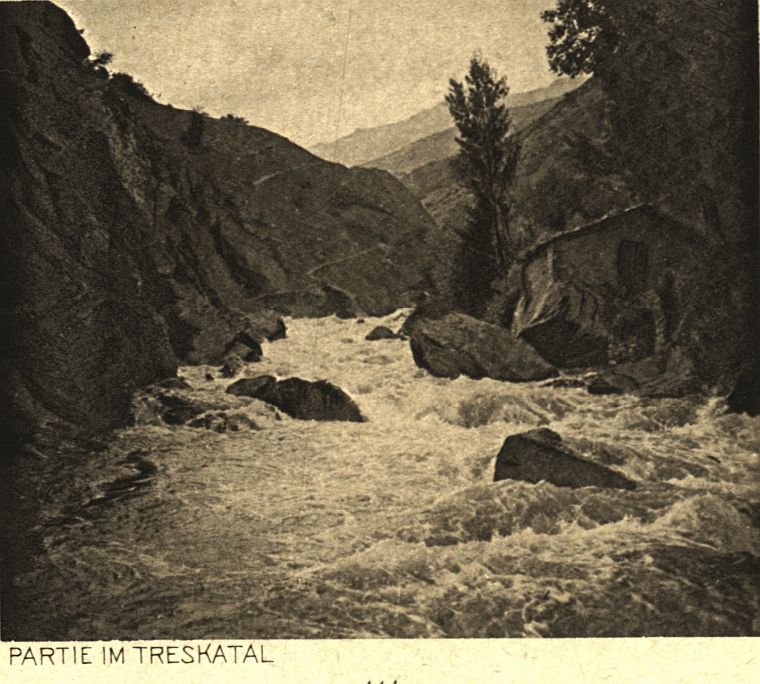
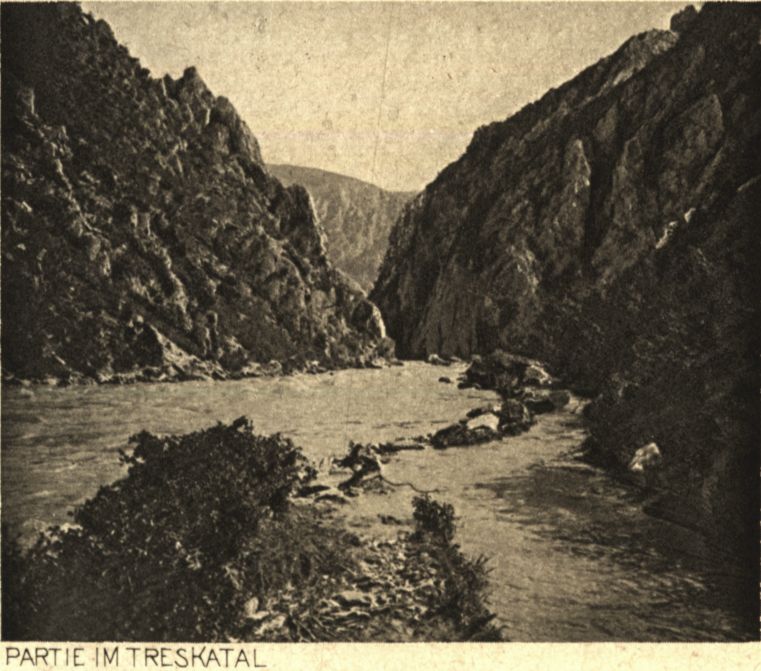
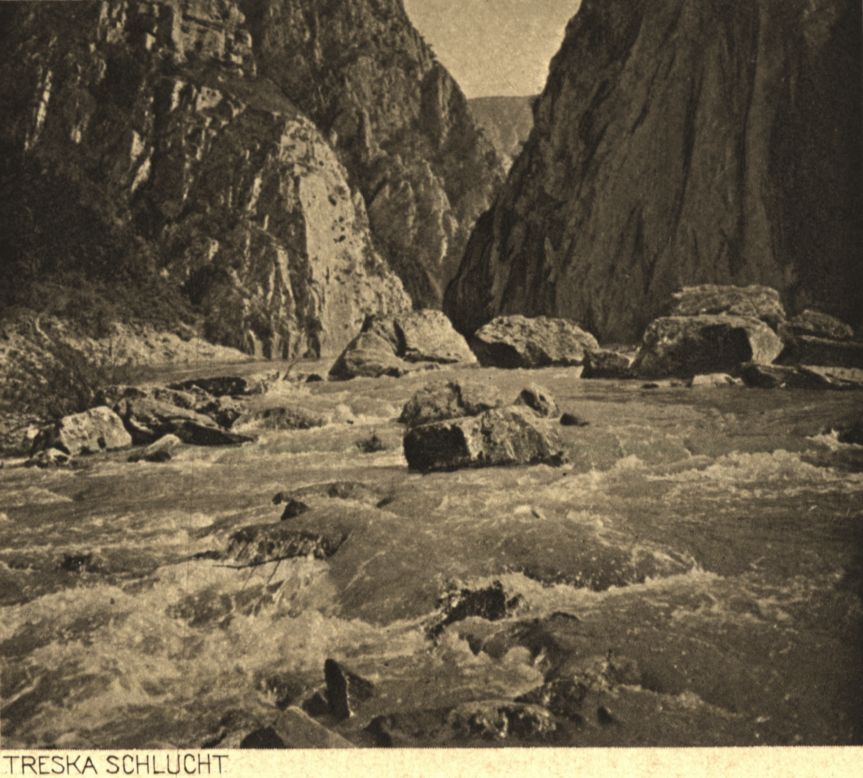
Kaluger -kaloyeros (from Greek - καλός-γηρος - good elder) .
The Codex is actually a dedication (a commemoration list), from where these names are mentioned during church services – for good health of the living, and for a place in the kingdom of heaven for the dead. Before the names the dedication section, is written that it should be read during the liturgical service, every Saturday. This confirms that there were regular worship services in addition to the Sunday services, when by tradition in the monastery of Matka, all the ascetics of the caves and hermits would gather for a Liturgy.
The Liturgies were served even at the request of the faithful, which is carefully written alongside their names in the Codex.
The Codex names all the Orthodox inhabitants of the cities: Kicevo, Debar, Ohrid, Kastoria, Veles, Prilep, Janina, and others, as well as the villages throughout the area of Skopje, some of which do not exist today, or they exist, but lack Christian residents. According to records in the Codex, the population of Skopje was divided into nobility and layman. Evliya Chelebija, in the 17th century describes: “the population of Skopje is composed of merchants, farmers, craftsmen and scholars.” The nobility was mainly of Orthodox Christians, and it’s believed that it contributed to the continuity of the life in the monasteries in Skopje, and the surrounding area, even after many centuries under the Ottoman rule.
Certainly, the main reason for this is the proper spiritual life of the monks, laid on the foundation of the ascetical-hesychastic Tradition. Hence, the respect of the residents towards the monks, about which D-r J Hadzi-Vasilevich wrote: “The name monk, can hardly be heard in the Skopje area. The people used to call them kalugeri (monks) and they were more appreciated than the clergy. The kalugeri (kaloyeros) were considered well educated. Confessors were only the kalugeri. They were addressed as ‘grandfather’ by the people and ‘duovniche’ (spiritual father), and the priests are referred to as ‘Father’ or less frequently with “dedo pope”(‘grandfather, Father). In the monasteries in the 19th century, there were few kalugerki (nuns) . “
Among the Hieromonks mentioned in the Codex are: Abbot Hieromonk Metrophan, Hieromonk Basil, and Hieromonk Theodore of Marko monastery, then from Krushopek the Hieromonks Nestor, Avramij, Anthony and Ananij, monk Paphnutius of Ohrid, the monk Theodosius from Prizren, from the Shishev Monastery, Hieromonks Nicodem and monk Theodore, Hieromonk Sylvester from the village of Gorno Sonje. The priests that are mentioned are from several villages and towns: Krushopek, Glumovo, Shishevo, Dobridol, Prilep, Grachac, Kuceviste, Orizari, Skopje, Matka, Rakotinci, Bojane, and Zhemirci. Which means, at that period, the monastery was very active as a spiritual centre, with a secure material position which allowed them to accommodate a vast number of clergy and believers, which were investing themselves in it (by personally helping the monastery).
The Codex was written in continuity. One entry in the manuscript testify that it was transferred to Shishevo monastery when the abbot Hieromonk Savatij, of the monastery Dormition of the Most Holy Theotokos – Matka, crossed to St. Nicholas in Shishevo, which before the fire, in 1897 was borrowed by monk Chariton in the Bigorski monastery, and taken later, from there to Sofia.
Hieromonk Kiril Pejcinovic. Manuscript collection.
According to the folk tradition present among the local population, in this monastery, probably due to the favorable location, there were many monks and priests. Literary activity was constantly cultivated, and there was a library, whose books were used for the monastery’s own needs, but were often borrowed, and taken to the surrounding monasteries, and beyond.
Owned by the monastery, is a handwritten manuscript, Minei (a biography of the saints commemorated in that month) for April, dating from the 15th or 16th century. It is written on paper, and contains 113 pages. A manuscript of the monastery Matka, was also one Oktoih (a book of liturgical hymns for singing in eight parts), in which there is an inscription from 1687. In the inscription is mentioned that the book, at the time of Bishop Estimij and the spiritual father Antonij, was given as a gift to the monastery of Most Holy Theotokos, near the river Treska, by the brothers Andrej and Stojan Kovach.
Pentacostar, in manuscript, from 1488, was used in worship services in the monasteries of Matka, which often functioned as a community. The manuscript remained in the monastery probably after 1801, until 1909. It was written by two writers, the second of whom is known – the monk Eustratius.
On the inside of the back cover is the inscription of Fr. Kiril Pejчиinovik, in 1801, abbot of the Mark’s monastery, with his signature.
To be known that in the summer of 1801 from Christ, came a sinful kaloyeros (monk), who was abbot of the Markov Monastery, who was from Dolni Polog from Tearce, who was called priest Kiril, I say that despite his sins he had no part in either the monasticism or the abbotness, but only by his name he was, and there were no virtues at all, but you brothers and fathers say – Christ God forgive and rest the soul of the sinful Kiril the hieromonk, remember me and protect yourself from sin, so that my soul, and yours, and all the Christian souls who presented themselves( before God) in Shishevo and everywhere, to be inhabited by Christ himself in his kingdom, amen.
„Кiril Pejchinovik is one of the most prominent Macedonian church figures at the time of the revival. He was born around 1770/71 in the Tetovo village of Tearce; studies in the neighboring village of Leshok and in the Bigorski monastery “St. John the Baptist ” from the prominent church educator Joakim Krчоovski.
He started his monastic life in the Hilandar Monastery and the Kichevo Monastery “Introduction to the Theotokos – The Most Pure”.
From 1801 to 1818 he was abbot of Marko’s Monastery “St. Dimitrij “; in 1818 he returned to his homeland, renovated the Leshok monastery “St. Athanasius ”and remained in it until the end of his life (March 12, 1845).
During his abbotship in these Macedonian monasteries, Pejcinovic managed to establish rich libraries with old Slavic manuscripts and old church books in them. By collecting these books from desolate churches and monasteries, he actually saved the literary and cultural heritage of paramount importance for the history of our country’s church literature and written tradition. In the libraries of Marko’s and Leshok monasteries were found several parchment manuscripts, as well as manuscripts in which are preserved transcripts of literary works of St.Clement of Ohrid and other medieval church writers. “
(… Academician Gjorgji Pop-Atanasov)
Monk Auxentij. Monastic residence.
The Pentecostarion that probably in 1801 was brought from the monastery in Shishevo, was labeled by a monk Auxentij in 1846, where he wrote that it originates from Staro Nagorichane, and in 1801 was brought to the monastery in Matka, which he calls Most Holy Theotokos – Three-hand (probably according the icon of the Most Holy Theotokos (Presveta Bogorodica) Troeruchica).
The same monk was mentioned in the inscription in 1851 in one room of the today’s monastic quarters. It is known that in 1830 the abbot of the monastery was Hieromonk Anania, but at the last visit of J.H.K.-Dzinot in 1854 there was only monk Auxenti “that barely maintained the monastery.”
In 1857 is mentioned the Hieromonk Arseni, and the last abbot before 1900 is the Hieromonk Savatij.
Iconostasis and icons from the 17th to the beginning of the 20th century.
The icon of the Most Holy Theotokos with Christ, which is part of the iconostasis from the XVIII century, at the request of the believers who have built a prayerful relationship to the Most Holy Theotokos, respecting this icon of hers, was restored, and today is in the church on a special shallow carving .
According to a report by the Institute for the Protection of Monuments and Culture of the City of Skopje, the icon is of little value. Its value for the believers, for all of us, as an icon of the Most Holy Theotokos, the protector of our monastery and the city of Skopje, Macedonia, is enormous.
In this monastery, in their own time, stayed the Velichki Bishop Gabriel Hagiorite and his father, the monk Cyril (1972-74), who was counted worthy to see the light (from her eyes) of the miraculous icon of the Theotokos, which is now placed on the left side of the church, which back then was part of the iconostasis. There are traces of tears on the icon itself.

